Tortuguero – Turtles vs. Jaguars
In a previous post on the Monteverde cloud forest, I described Costa Rica as a country which seasoned travellers should have no difficulty navigating on their own, with a couple of exceptions. The first was Monte Verde, simply because of the very difficult road conditions and the second is the island of Tortuguero on the northern Caribbean coast. Getting there involves a long drive down a series of increasingly narrow country roads to a river landing where you then need to take a boat a considerable distance downriver to reach what is really just a village. Accommodations and restaurants are not that plentiful. Better to leave the planning to someone who knows the area, which is why I signed on to a weeklong extension to Costa Rica with Canadian tour company Adventures Abroad. The key was that the tour would be led by Andrés Fernandéz, a Costa Rican native who has been to Tortuguero many times before. It turns out that leaving things to Andrés was the right thing to do as, what could have been a s**t show if travelling on our own, was in fact, one of the most memorable few days in many a year. Here’s why.
Getting to Tortuguero
Once you’ve decided to let someone else do the driving, getting to Tortuguero is an adventure in itself. From San Jose we drove on a good highway about two and a half hours to the town of Cariari. This route took us through Braulio Carrillo National Park which preserves 50,000 hectares of rain forest along the slopes of some very steep mountains, over the Continental Divide and down into the coastal lowlands of northeast Costa Rica.

Leaving Cariari, things begin to get even more interesting. This map shows the route from Cariari to La Pavona where we leave the bus behind and take a boat the rest of the way. Note the yellow signs indicating a banana crossing.

Before reaching the banana crossings, Andrés sharp eyes detected a sloth hiding in the vegetation that covered a fence post right beside the road. We stopped and I got this close up shot of a two-toed sloth. He didn’t seem the least perturbed by our presence.
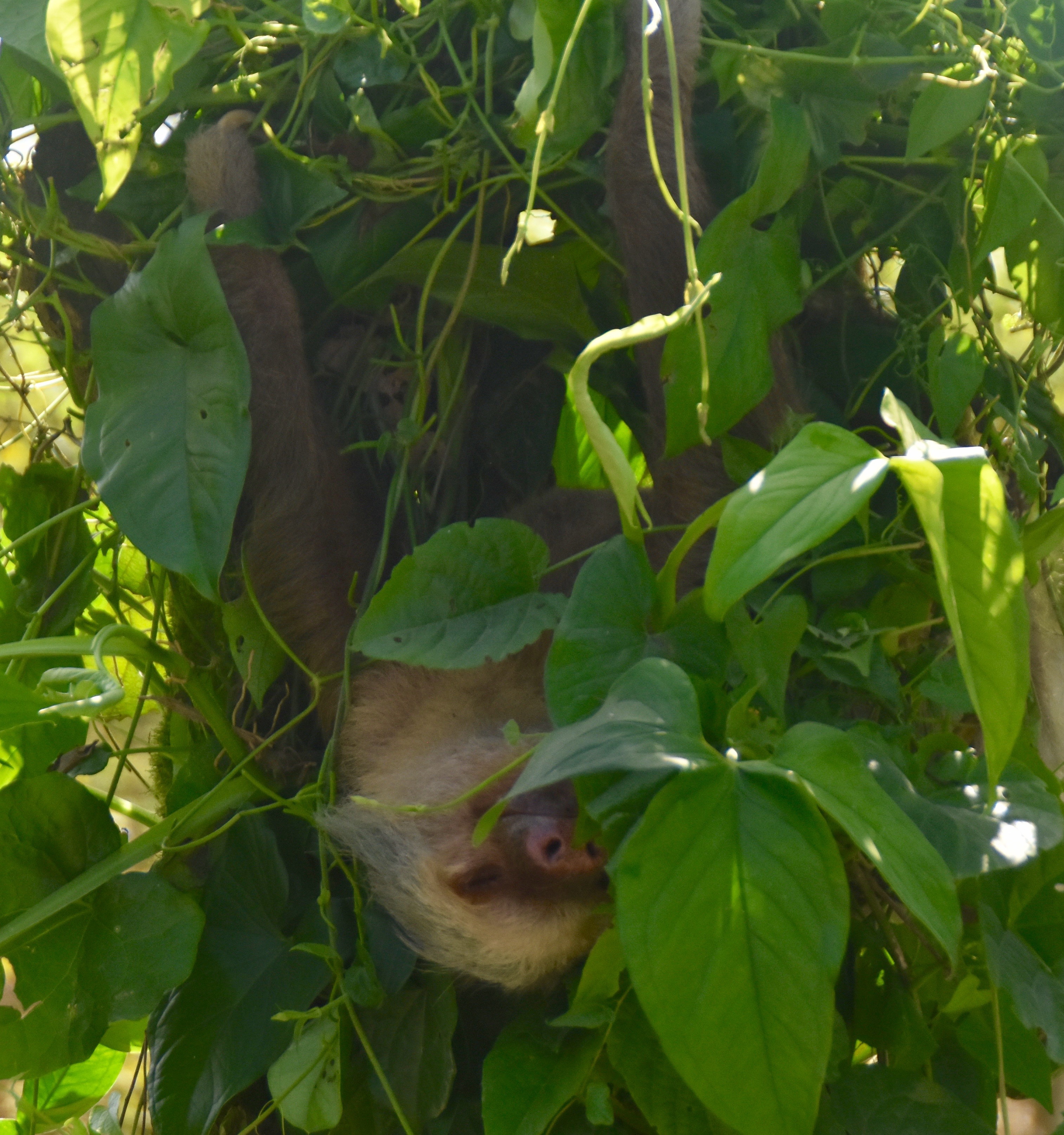
Back to the banana crossings. No, the bananas do not cross the roads on their own, possessing some secret method of propulsion unknown to man. They get a little help. This area is Costa Rica’s principal banana growing area and the banana plantations are criss-crossed with small elevated conveyors upon which the banana clusters are hung and then carried away to the packing plant. Where these conveyors cross the road, a barrier comes down just as if a train was approaching, and then along come the bananas. It’s actually a pretty cool thing to see.
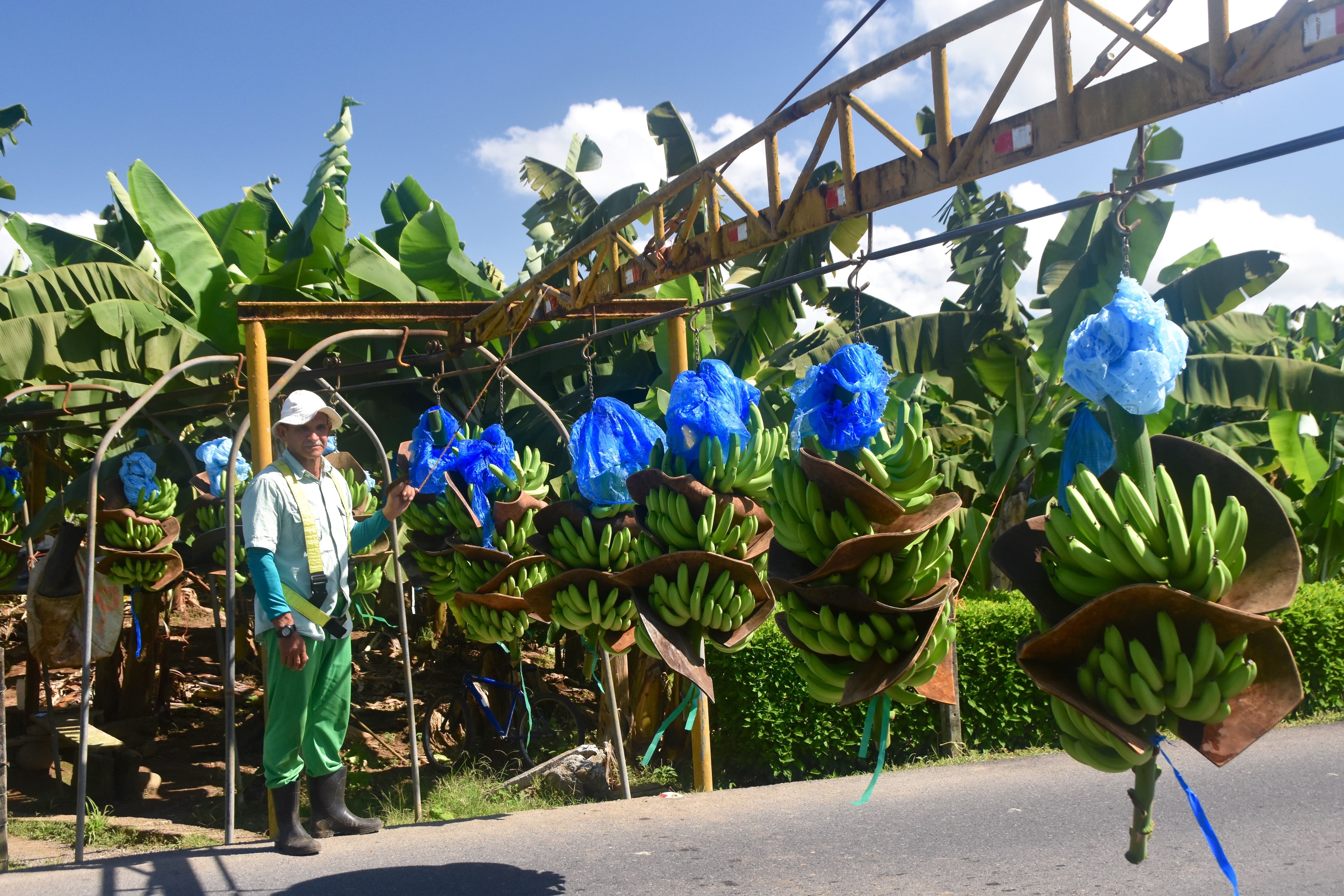
Not long after this crossing the pavement ends and the road narrows. Thankfully it’s not rainy or I could see this road turn into a quagmire. At last the bus pulls up to La Pavona, which is really just a large building with a restaurant and selling supplies. Judging by the way people are stuffing everything they can get their hands on into their packs you would think this is the last outpost on the Amazon. Not taking any chances myself, I do buy a few cans of Imperial, the excellent Costa Rican beer.
Here is the landing where there are quite a few boats waiting to be loaded. It’s a bit chaotic as there are boats like ours that have been chartered, others that provide regular scheduled runs to Tortuguero and others that are available for private hire. Somehow Andrés finds the right boats – one for our group and another for the luggage, makes a last trip to the building to find some stragglers and we get aboard.
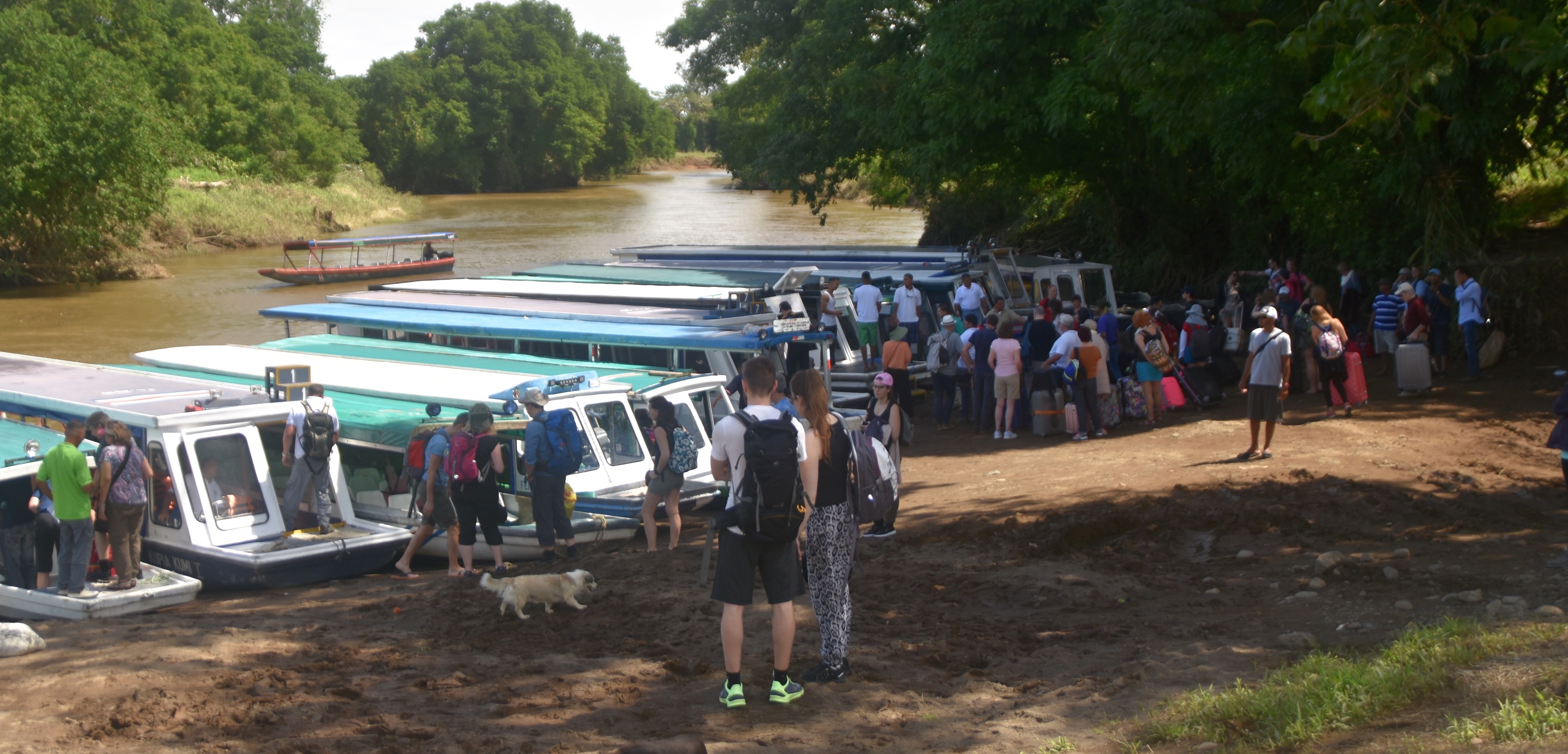
Here is Andrés explaining how long the trip will take and what to look for on the way there.
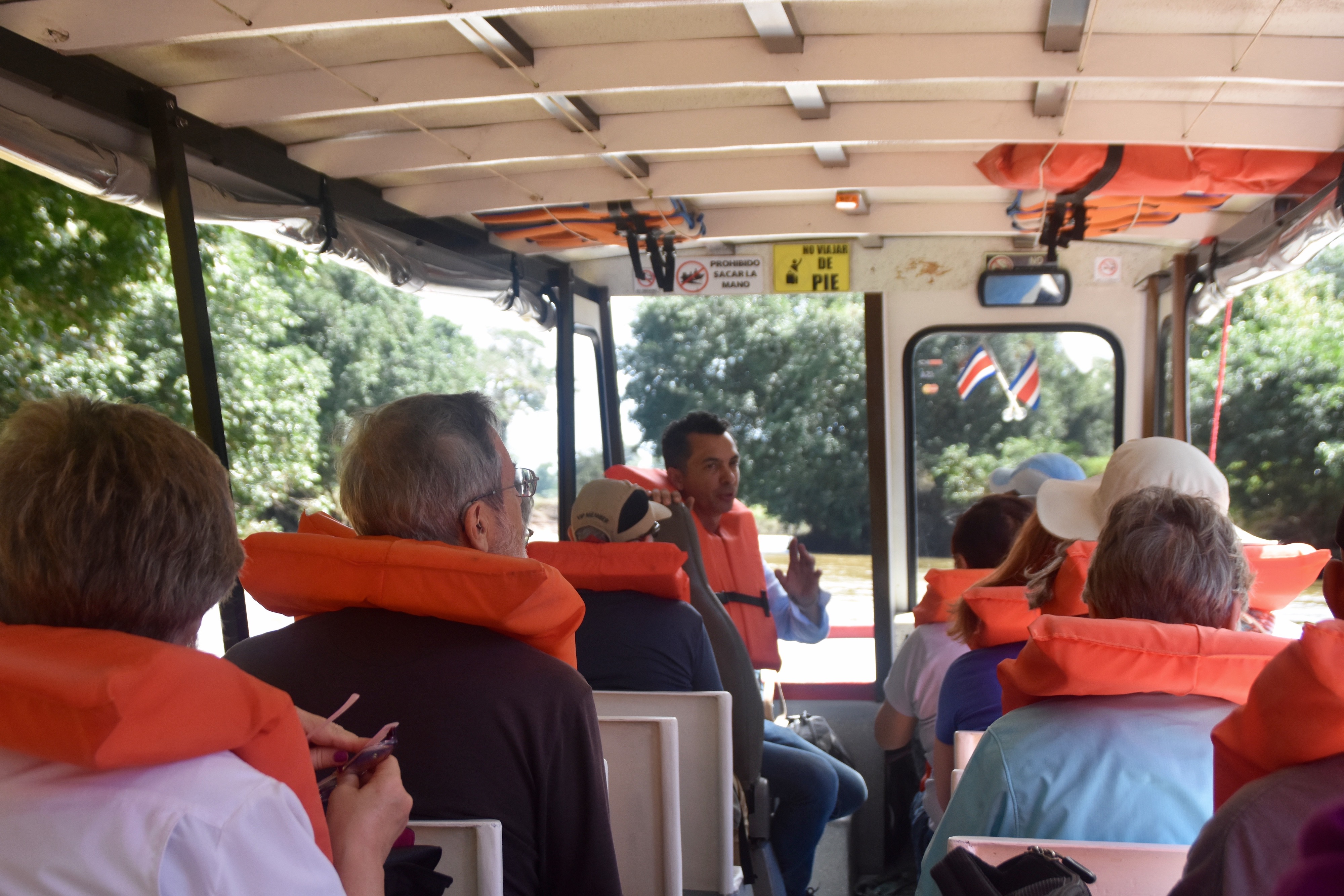
I’m given to flights of fancy whenever I get on a boat in an exotic jungle locale and always think of Conrad’s Heart of Darkness as you can tell from this video. However it does give you an idea of what to expect.
Oh, and I didn’t exaggerate in calling these crocodile infested waters. They are, as this photo proves. This was a big sucker.
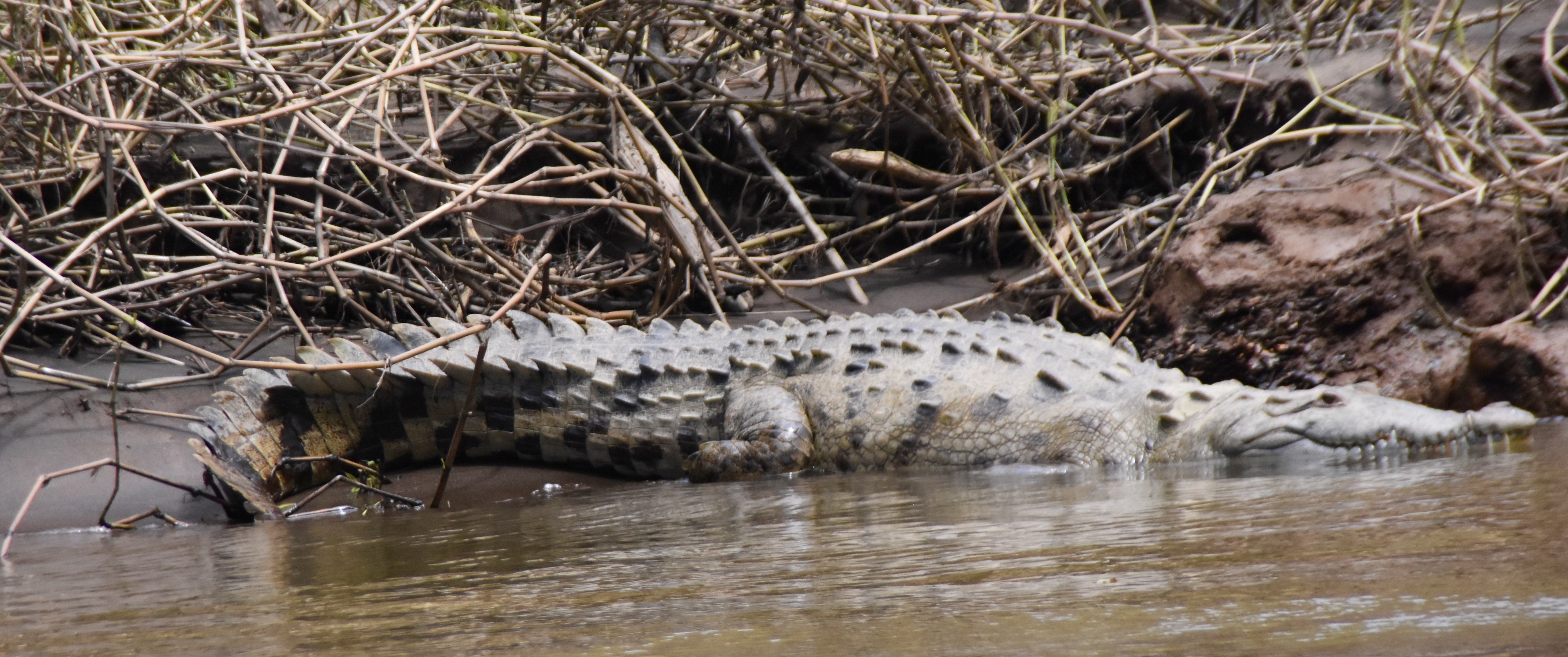
The trip down river took just over an hour and was accompanied by the screeching of parrots and howler monkeys living up to their name. There’s one now. I loved every minute of it.

This is an aerial shot of the village of Tortuguero which shows you there’s not much to it. We have just come around the bend after passing through mile after mile of nothing but jungle. It definitely has an ‘ends of the world’ feeling to it.
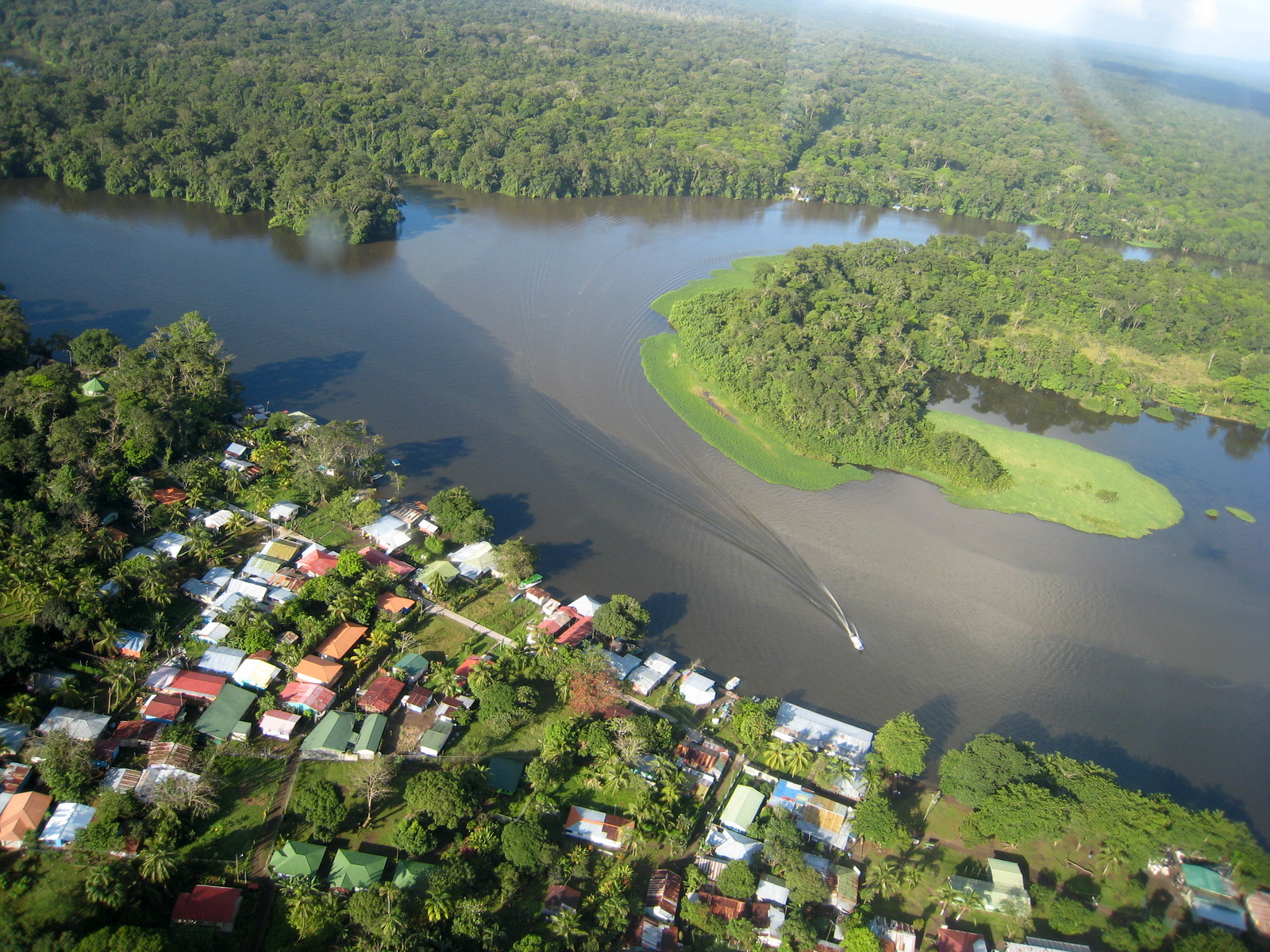
Miss Junie’s Lodge
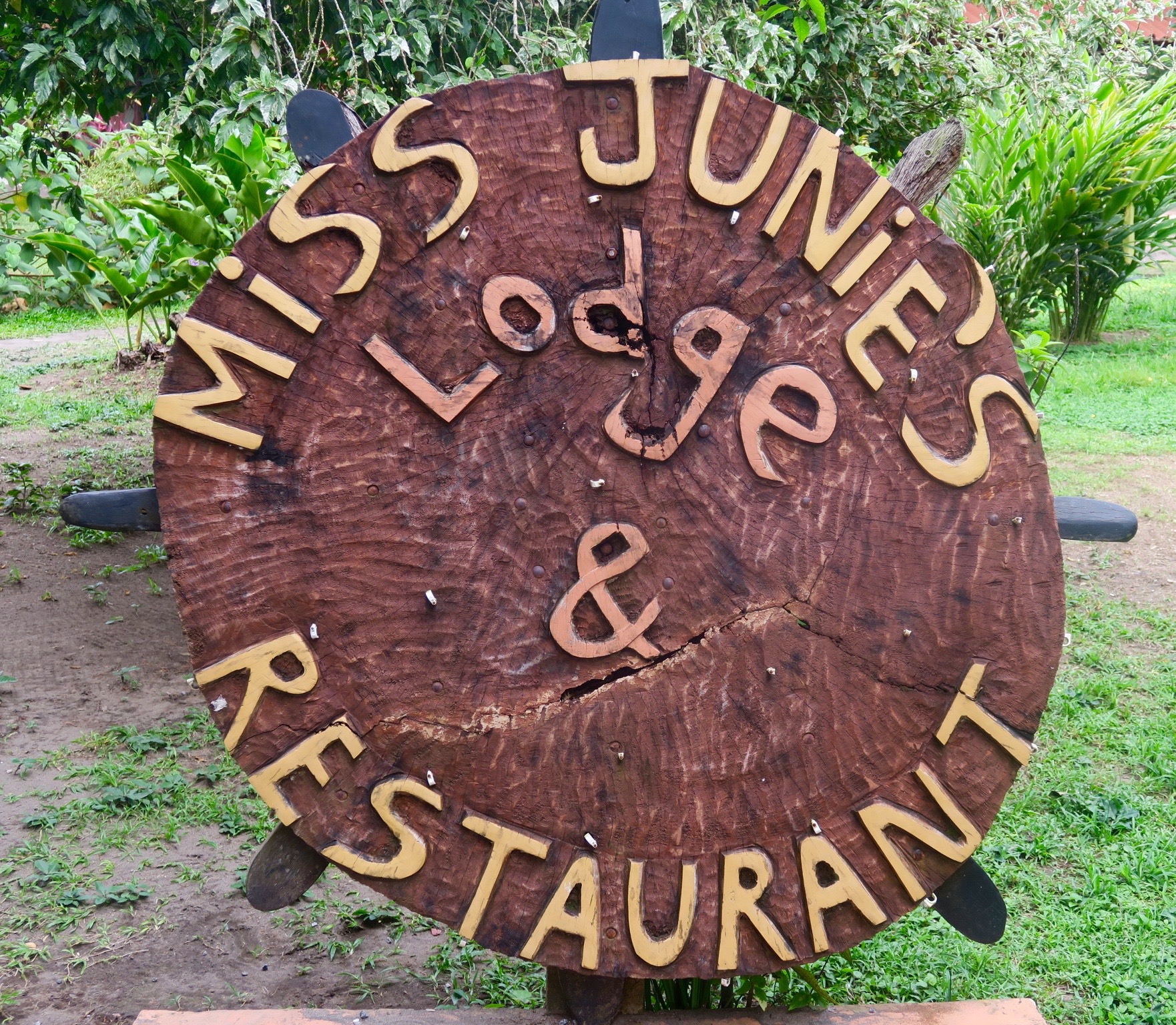
We landed at a small wharf and scrambled off at Miss Junie’s Lodge which seemed to be the end of Tortuguero’s main street. If you are looking for a resort town, don’t come to Tortuguero; it is the antithesis of that. Amenities are spare, but Miss Junie’s has everything one needs – a decent if creaky bed, a shower that works, simple, but tasty food and sometimes even the internet. We got a nice corner room on the second floor outside of which Alison and I sat, sipping on those Imperial beers I wisely bought at La Pavona and passing the binoculars back and forth while trying to identify the many types of exotic birds flying about. The expression “Less is more” is usually bullshit, but in Miss Junie’s case I think that’s true.
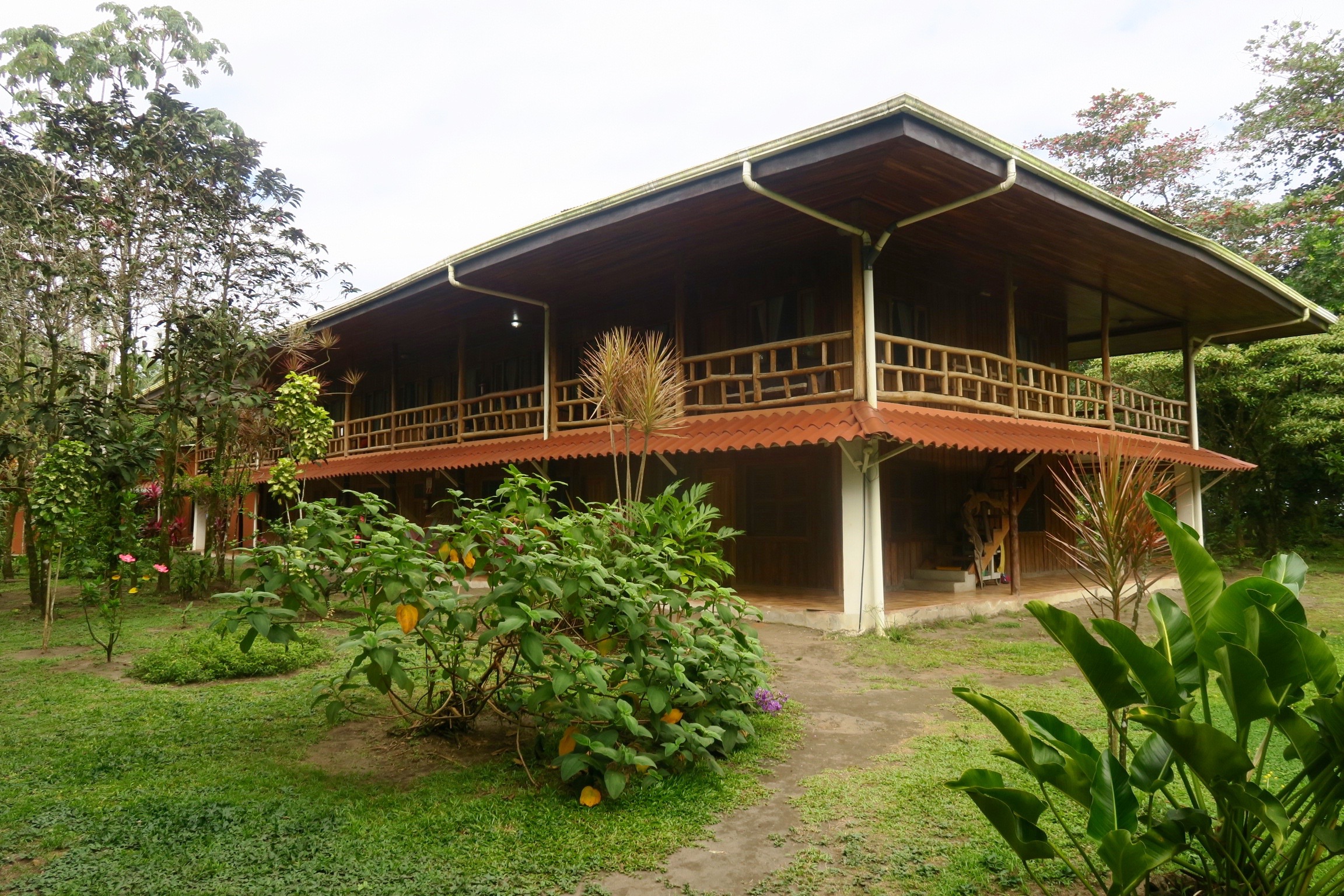
Later we wandered the grounds taking pictures of some of the wonderful blooms that were attracting the birds and insects.
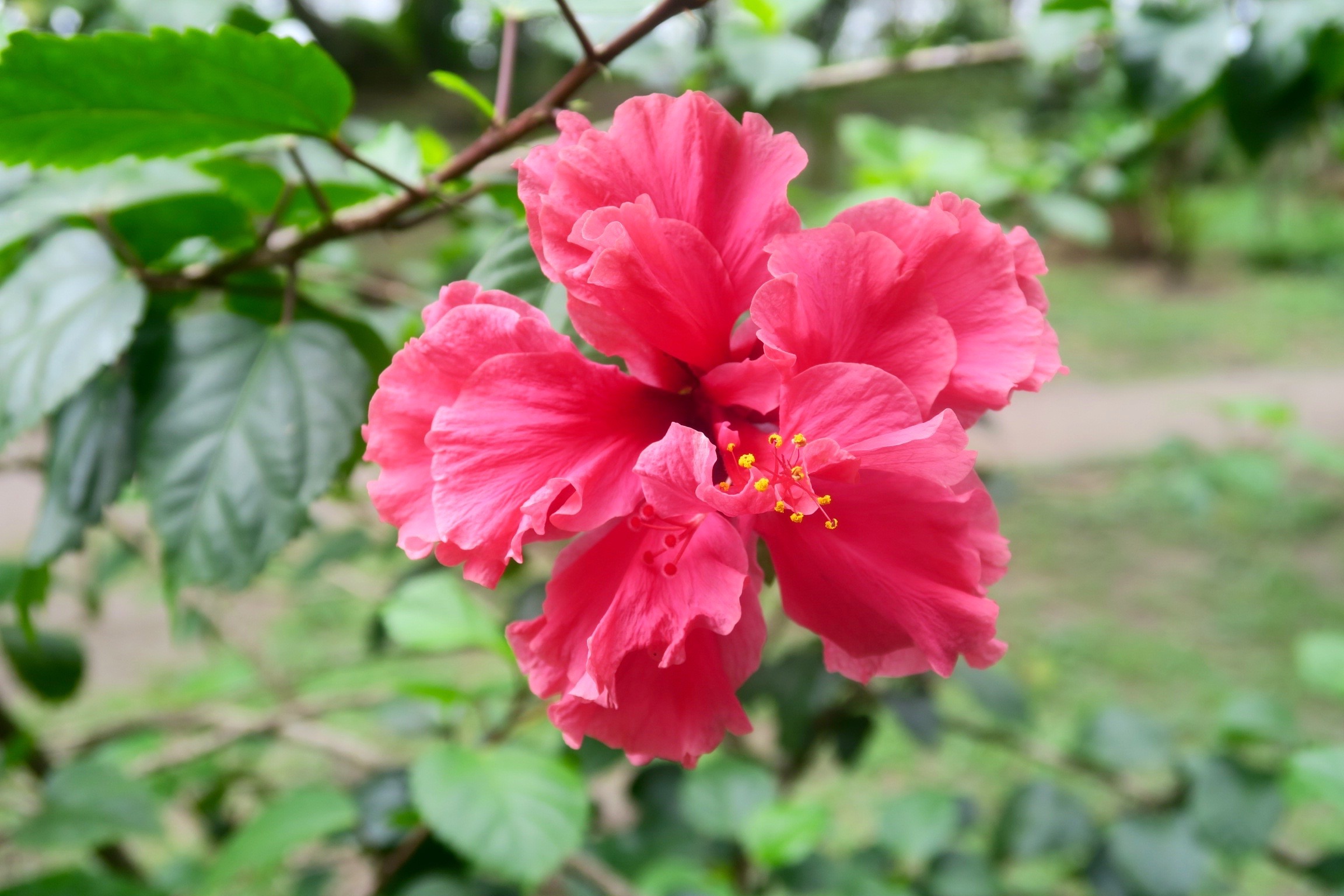

I loved this place.
Tortuguero Village
This is the main street of Tortuguero, actually the only real street at all. There are a couple of cross streets, but the distance between the open ocean on one side of the village and the river on the other is only a couple of hundred yards.
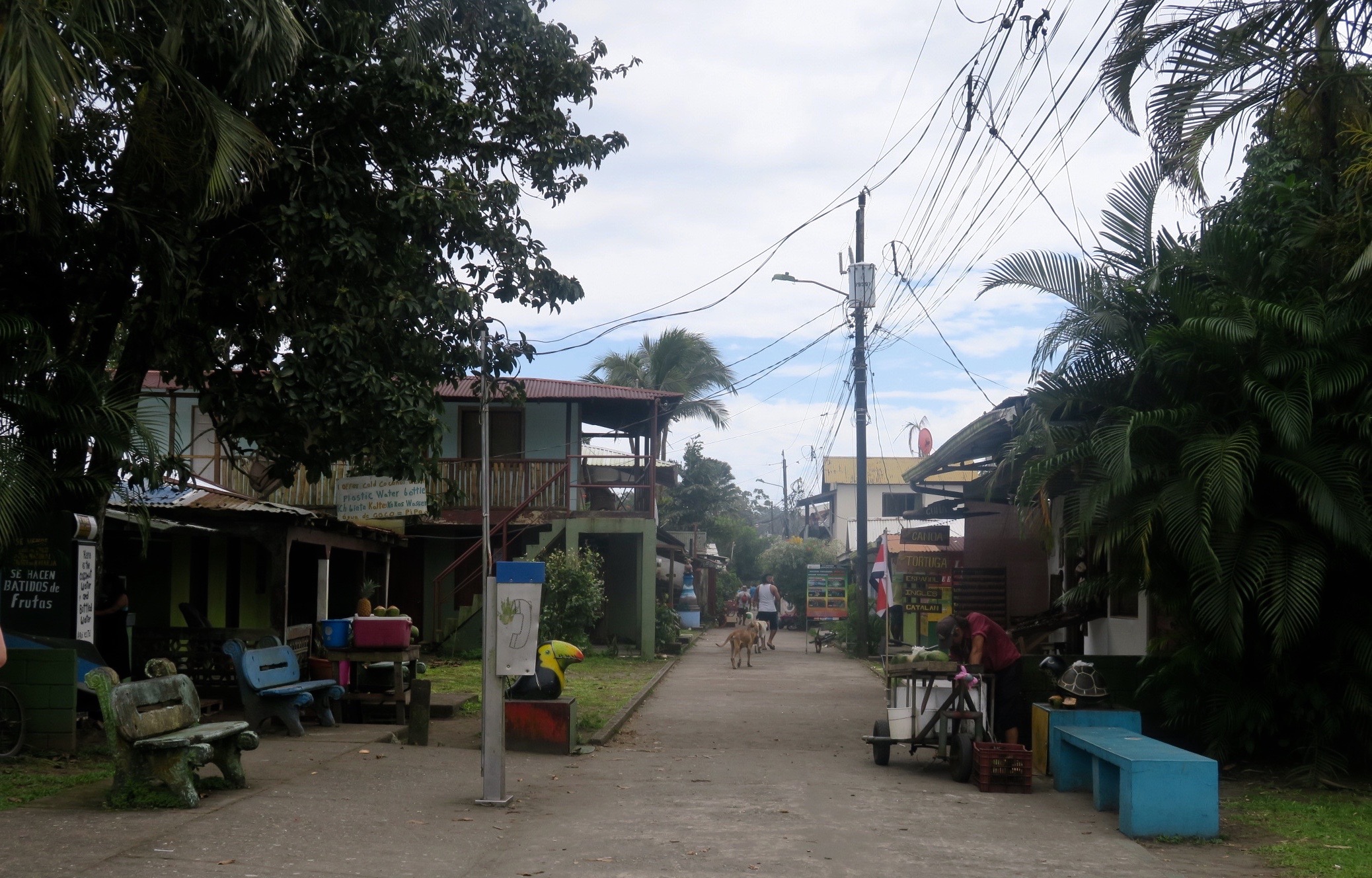
There are no cars. People get around by motorbike, bicycle or on foot, but everyone has a boat. You have to like that. Here are the highlights of a walking tour of Tortuguero.
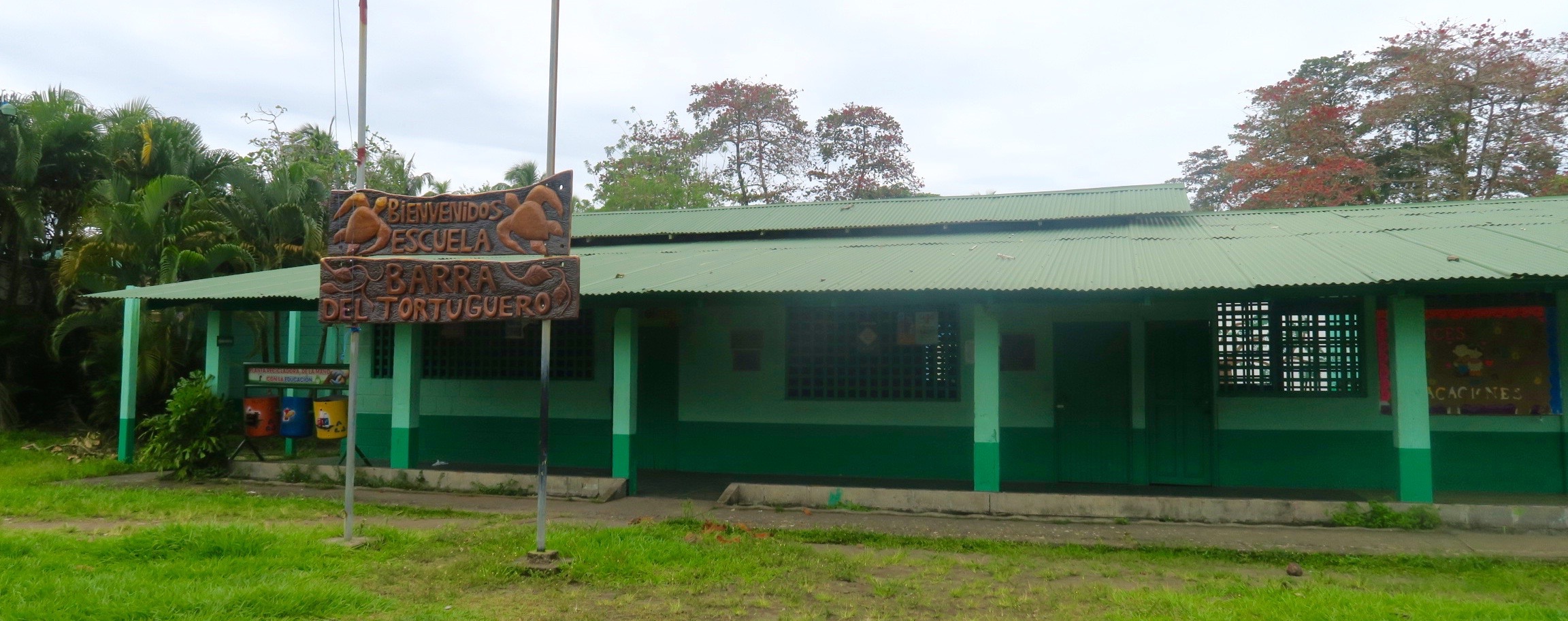
A tiny church complete with resident cat.
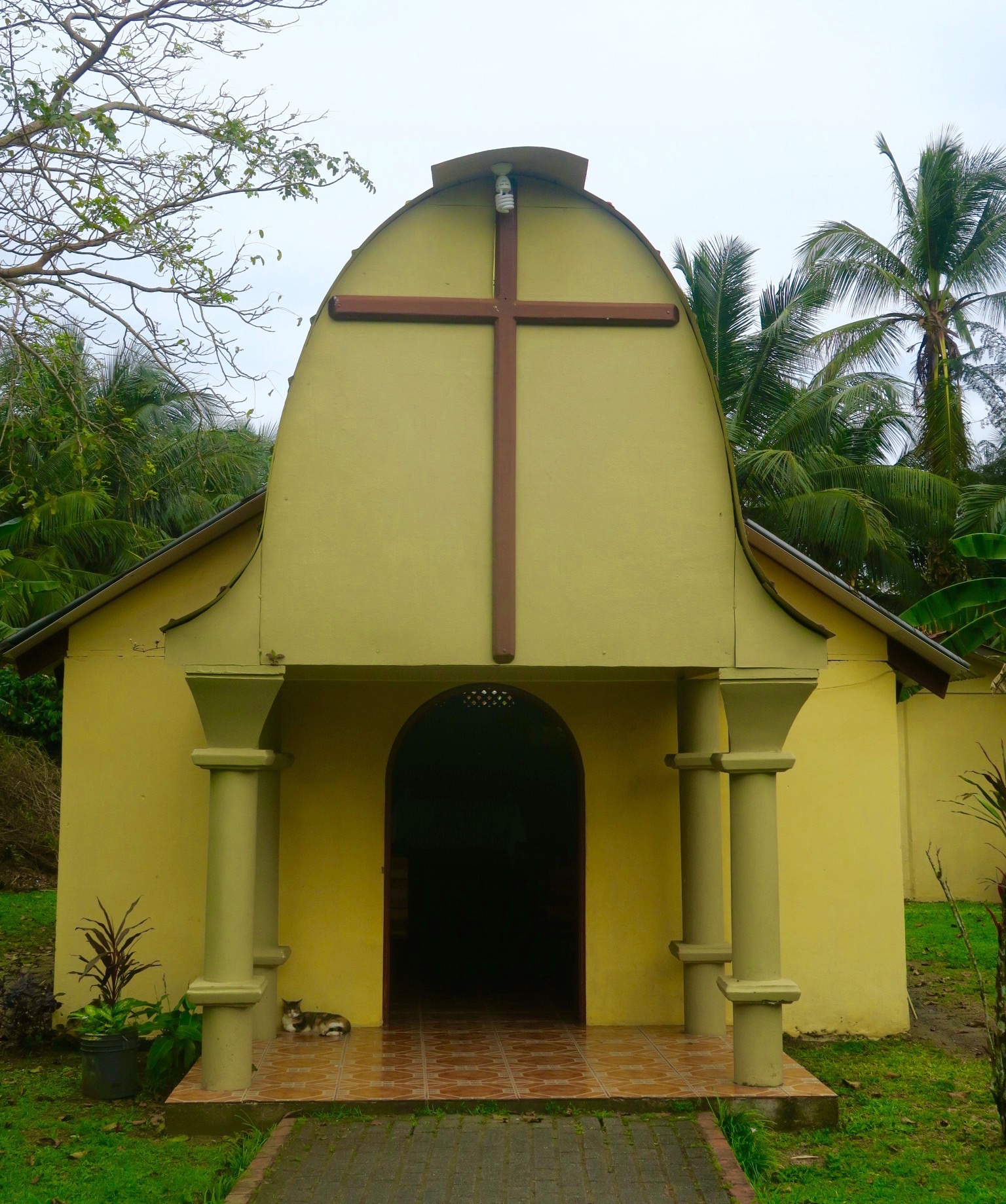
Garbage containers in the shape of native animals. The sloth.
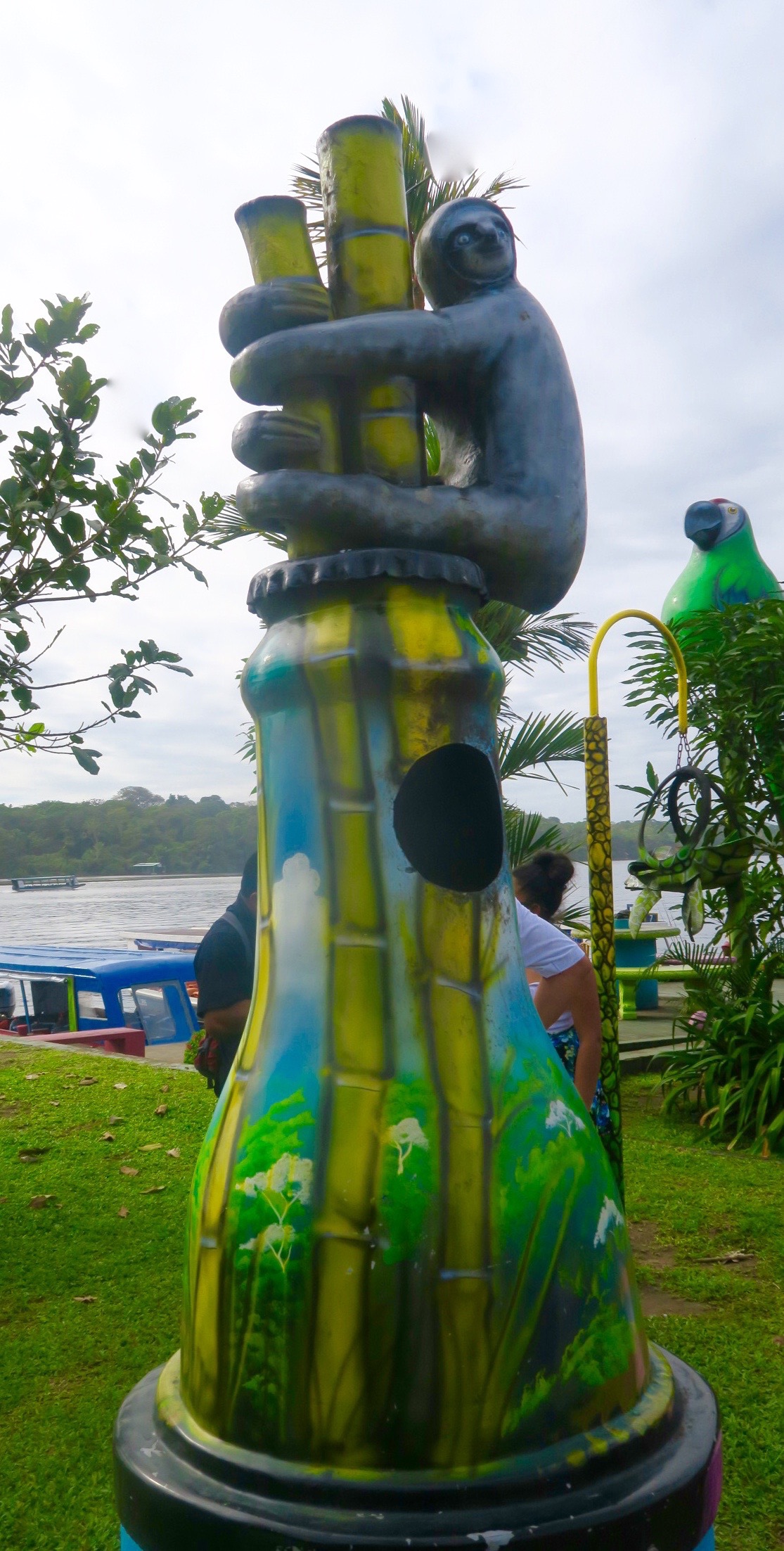
The tapir.
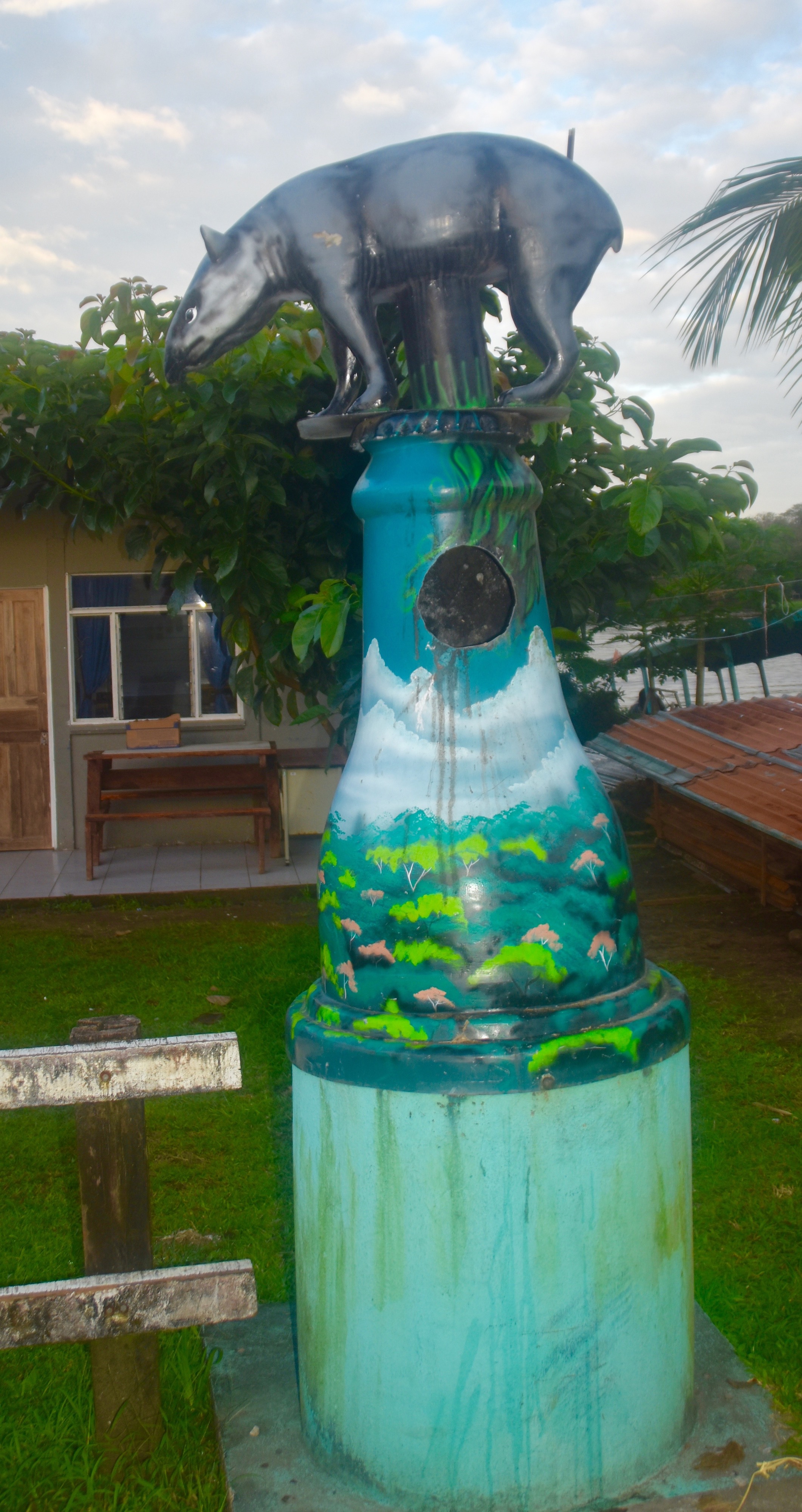
And the Pennywise. What happened to the child eating those watermelon slices?
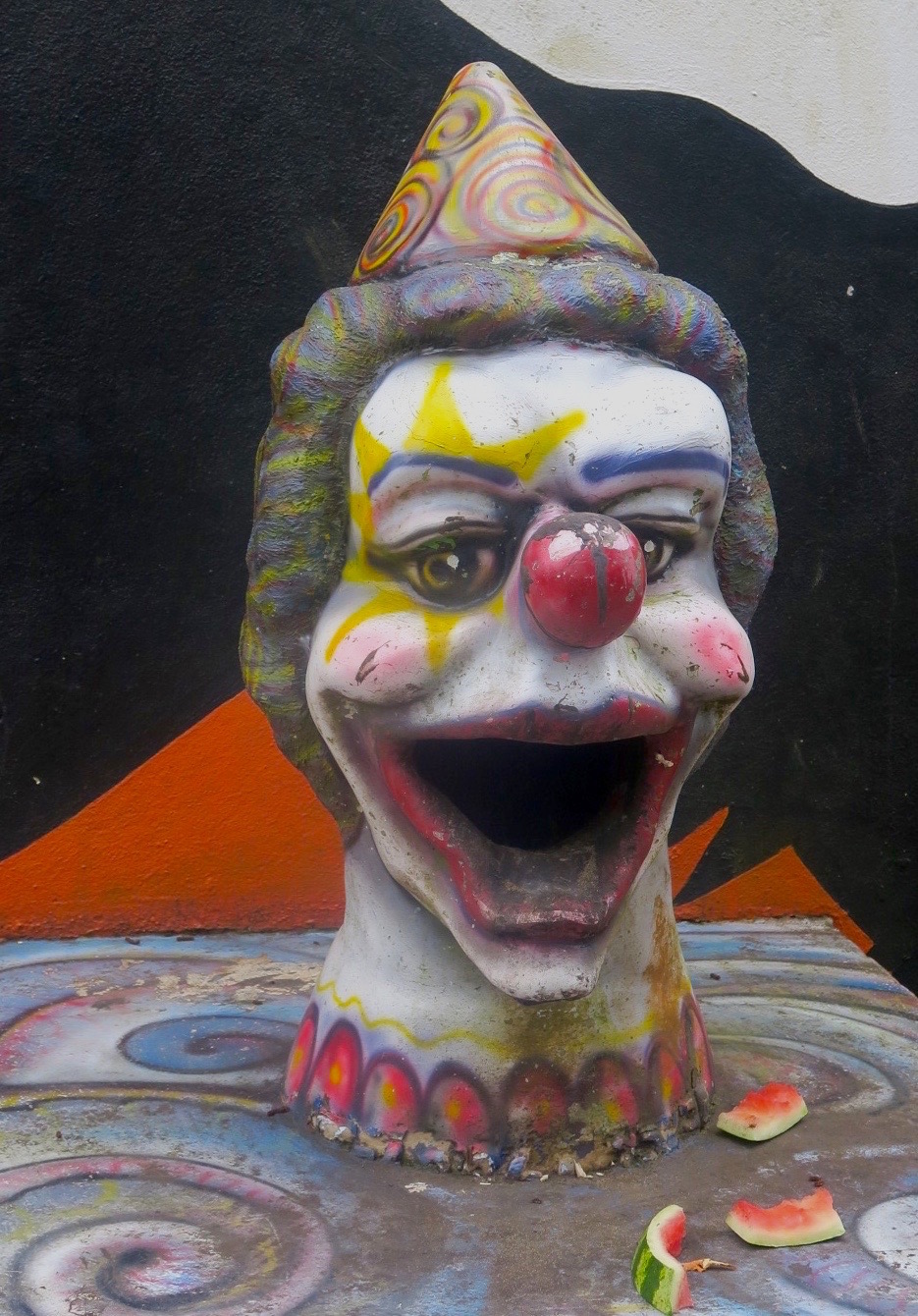
Lest this tour of metropolitan Tortuguero not convince you to drop everything and grab the next boat, consider this. You needn’t walk back to Miss Junie’s by way of the main street. Just a few paces off the main drag is the Caribbean Sea and the beaches that gave the place its name – Land of the Turtles.
Now this is a nice walk.
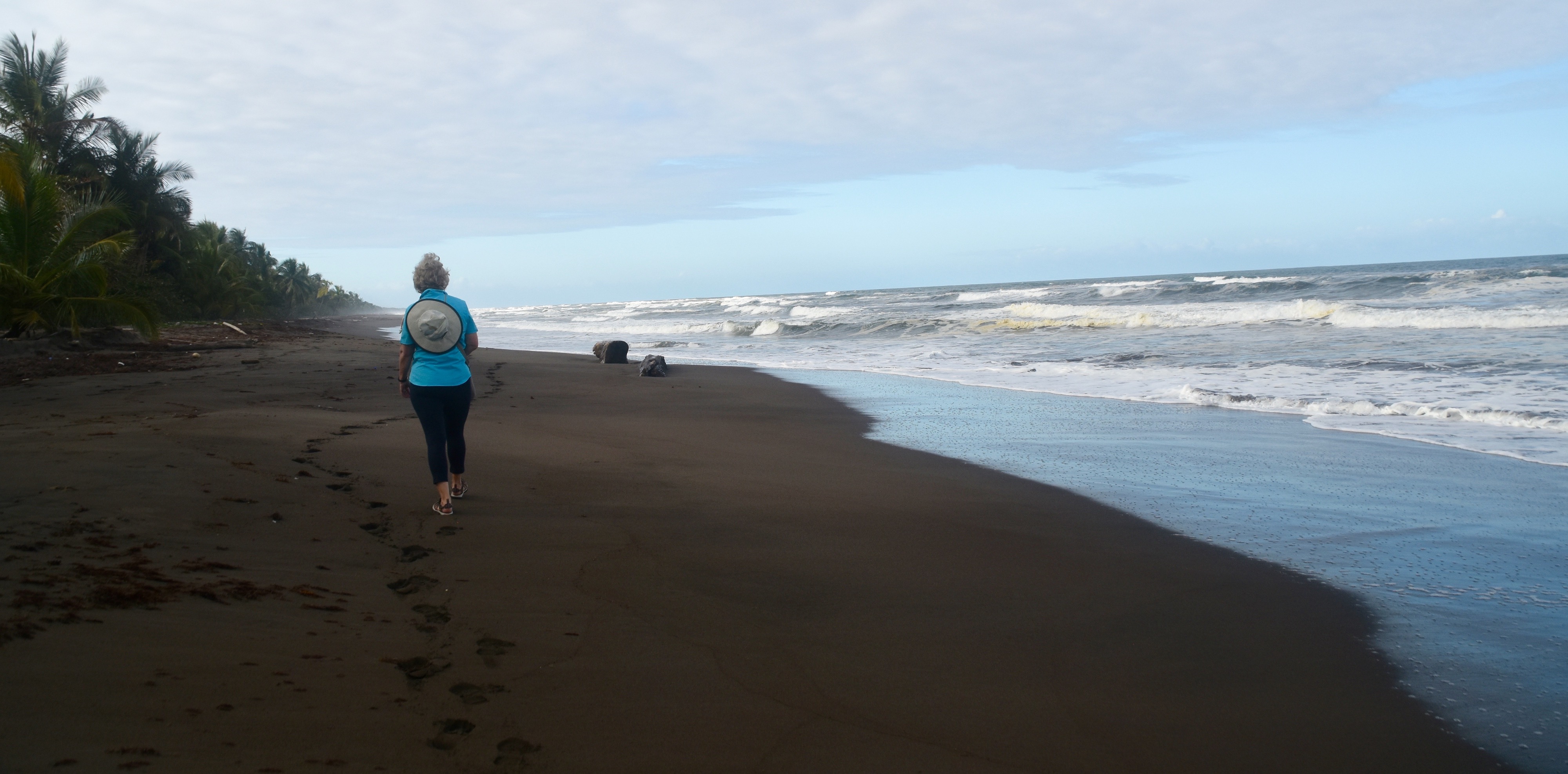
This dark sand beach stretches for 22 miles (30 kms.) all along the Caribbean side of Tortuguero and is the most important green sea turtle nesting site in the world. More about that later, but for now just enjoy the beach, just as this whimbrel is doing.
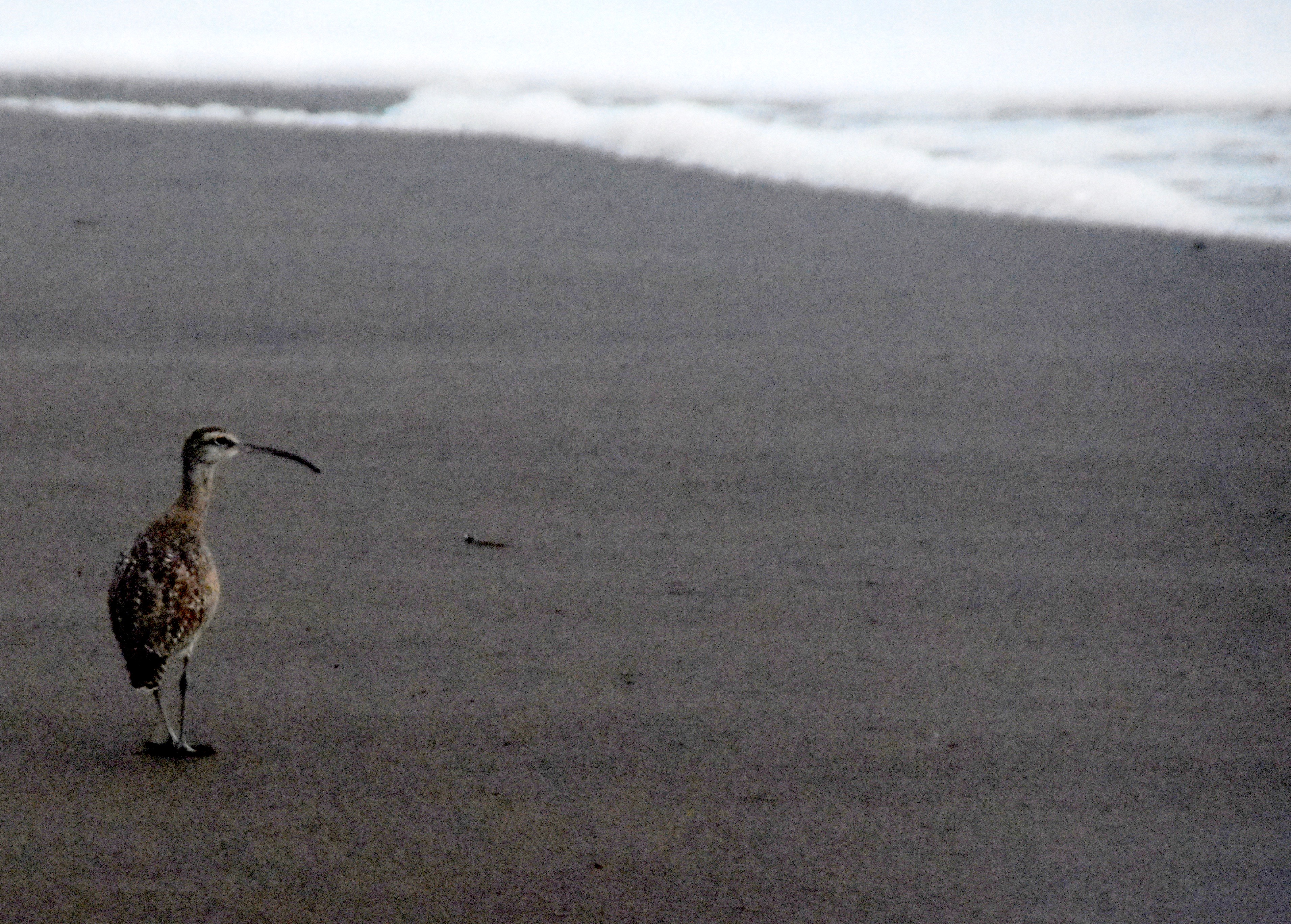
Here is a video I took on Tortuguero Beach.
So staying on the beach is the recommended course, but that’s not a bad option for photographers. There’s some great driftwood.
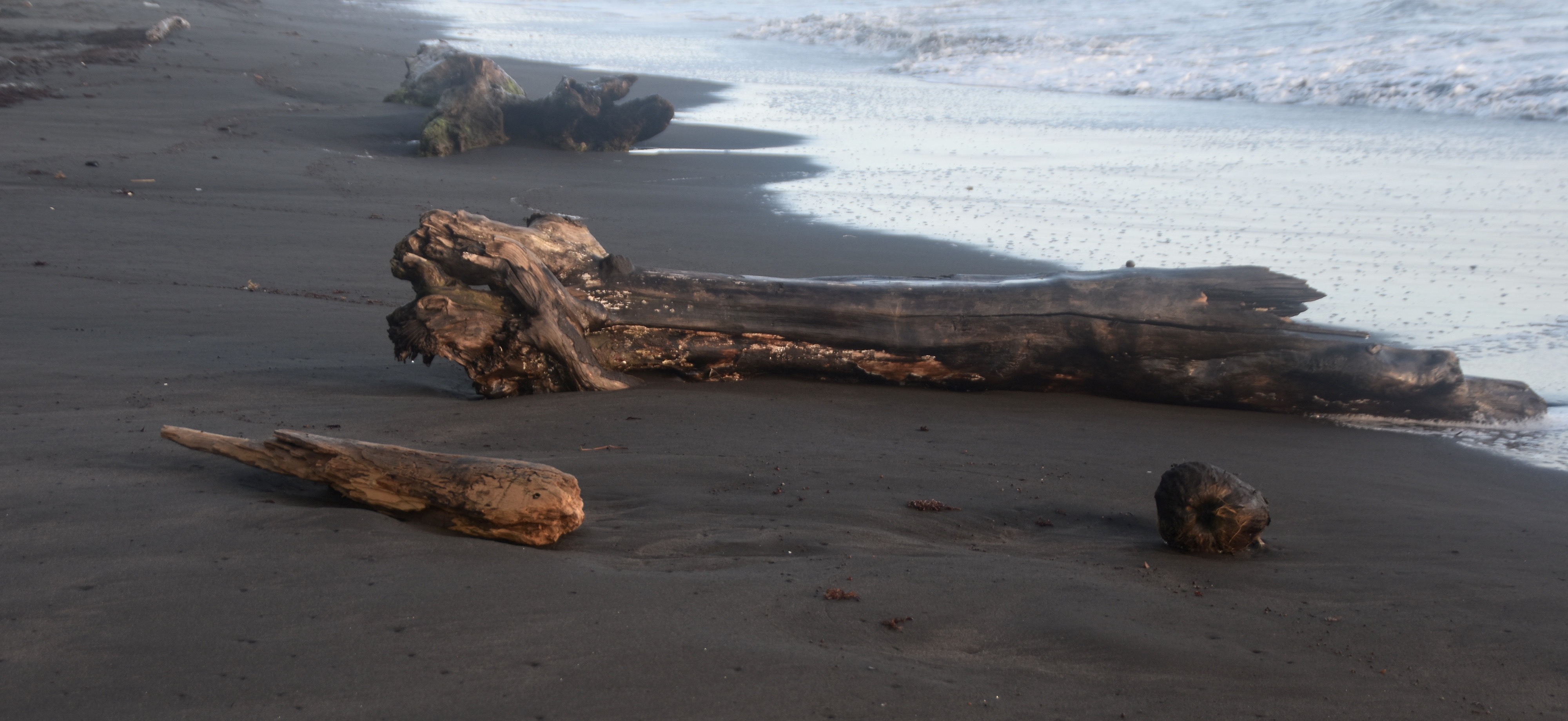

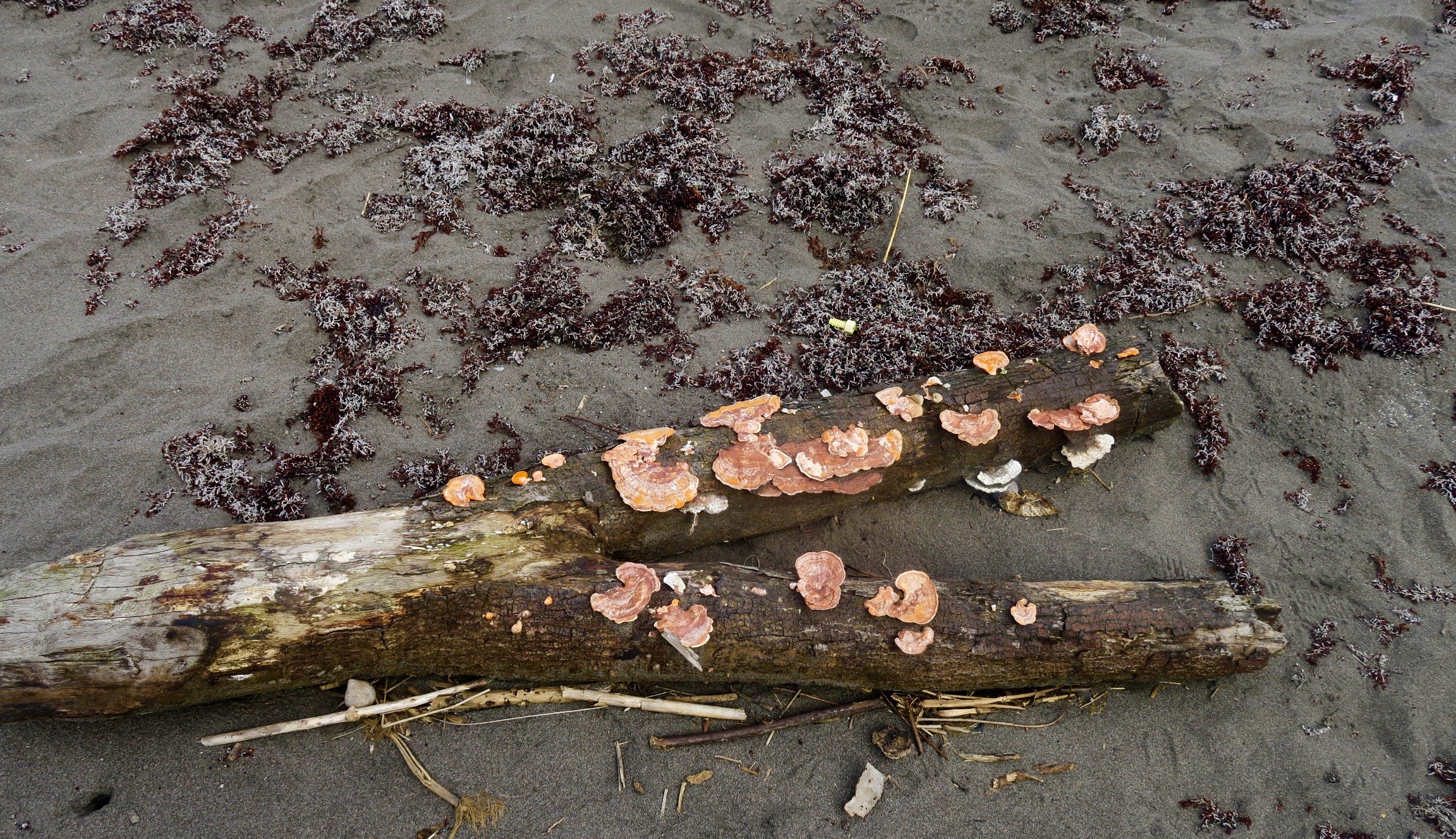
There’s also tons of bird life in the forest canopy that comes right up to the beach. I don’t care how many times I see a flight of wild parrots, in Tortuguero’s case, green macaws, I still get excited.
The Caribbean Conservation Corporation (CCC)
Back at Miss Junie’s, Andrés leads those who want to go a short distance to this non-descript green building. It didn’t look like much, but this where the movement to save sea turtles around the world began in 1955 when Dr. Archie Carr from the University of Florida began tagging sea turtles on Tortuguero Beach. In 1959 he founded the Caribbean Conservation Corporation (CCC) and almost single handedly awakened the world to the plight of marine turtles and the alarming rate at which they were disappearing.
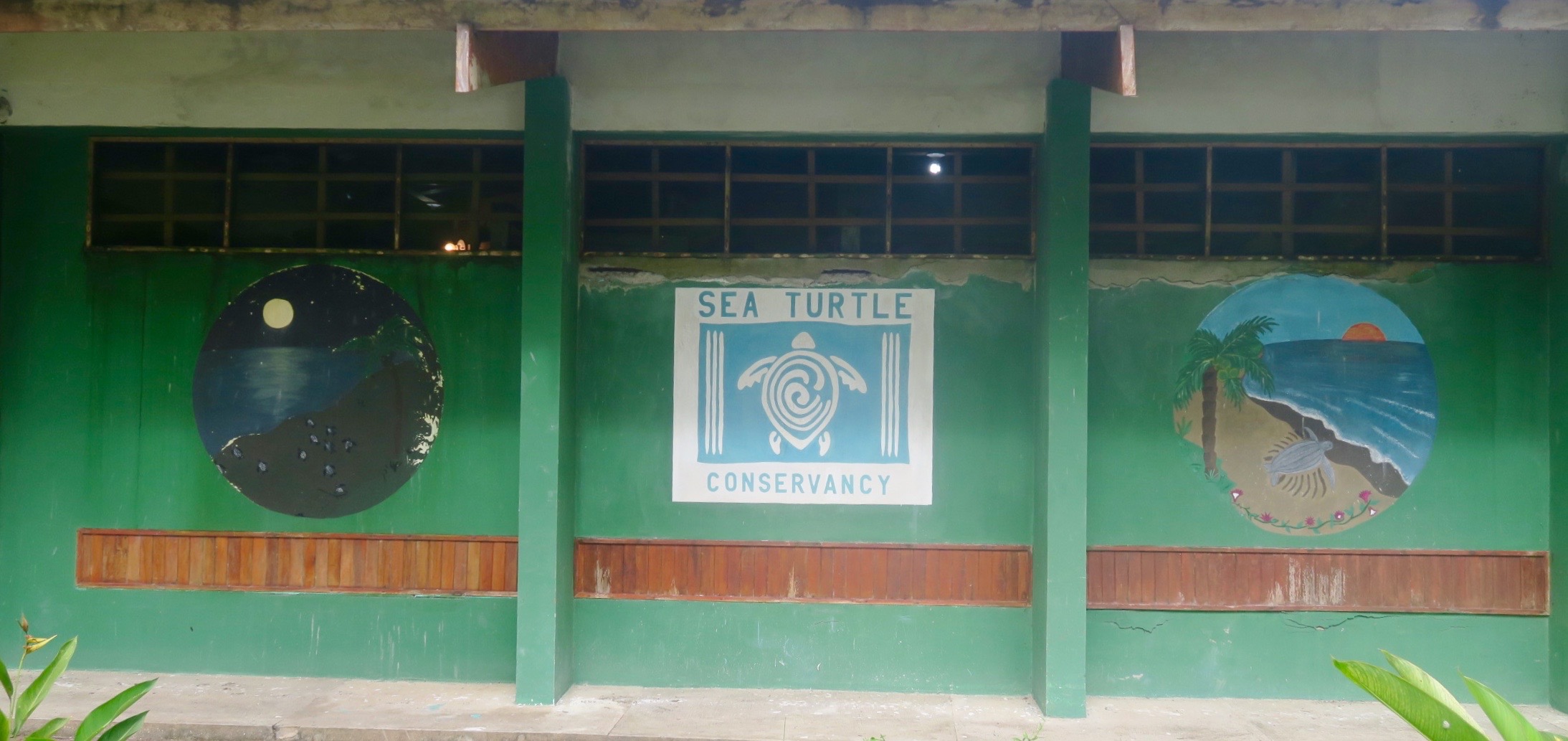
Tortuguero was long known to be a huge nesting site for green sea turtles and a few other species. But that knowledge had been put to bad use by the locals who mercilessly slaughtered the turtles for their meat, dug up their eggs and made souvenirs out their shells. This was not just on Tortuguero, but pretty well everywhere sea turtles bred – they were just viewed as an inexhaustible resource that would always be there. Except, they wouldn’t be if things didn’t change.
It was on Tortuguero that sea turtle tourism was first developed. The CCC through Dr. Carr’s efforts convinced the people who depended on the sea turtles for a living, that there was more money in preserving them than killing them. Of course, like all new ideas that seem ultra radical at the time, it was resisted, but today the people of Tortuguero make far more money from turtle tourism than they ever did in the past. Over 50,000 people a year pay big bucks to come to Tortuguero during the green turtle nesting season to watch the turtles lay their eggs and return to the sea. It is all done in very small groups and as unobtrusively as possible and it’s working. Green turtle numbers are up dramatically. It really is a win-win-win situation. Turtles are better off, locals are better off and tourists get their monies worth.
Inside the small building which is actually an active working station and not a museum, I came across this whiteboard with, what to me, was an amazing fact.
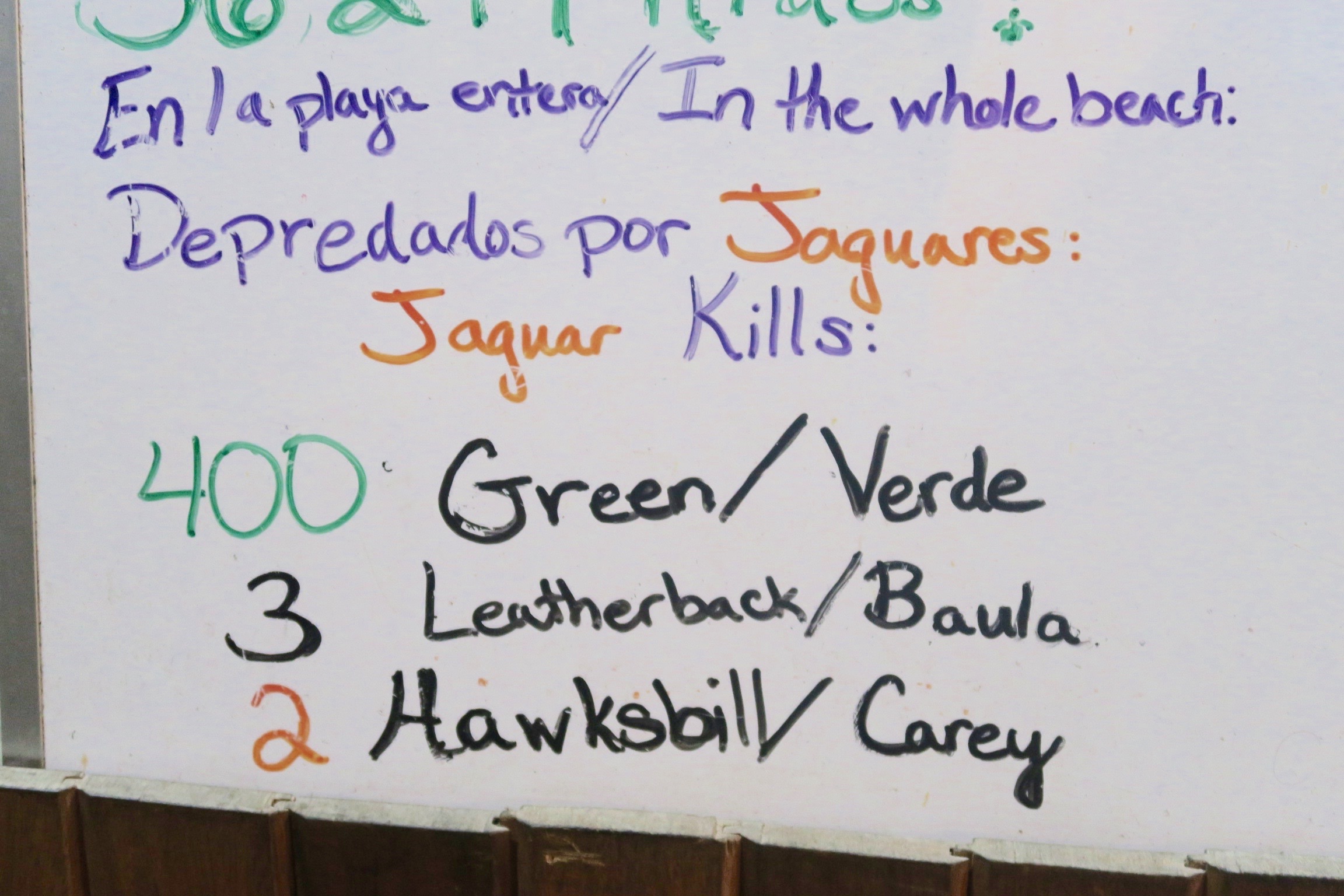
I had no idea that jaguars killed sea turtles and in such great numbers. Now that the humans are under control the jaguars are out of control. Didn’t anyone tell them that the sea turtles are endangered? Oh wait, so are the jaguars. This is a tricky one and applying human mores just doesn’t work.
Wildlife Watching on the Tortuguero Canals
The next morning was beautiful and calm as this photo taken from Junie’s wharf attests.
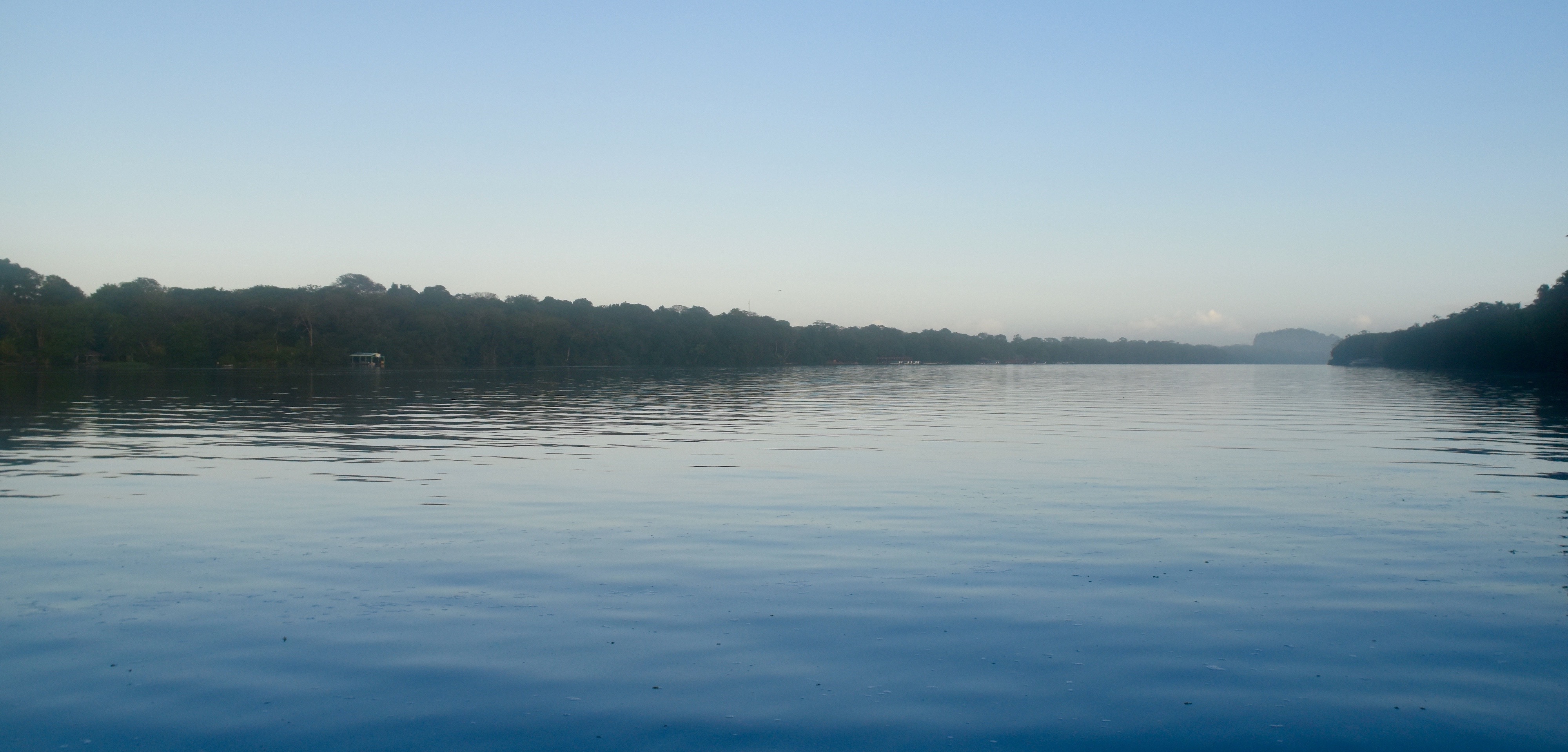
After breakfast our small group boarded a flat bottomed-boat with a small horsepower outboard and headed out to do some wildlife watching on the canals and tributaries of Tortuguero. Our local guide had the eyes of a hawk and ears of a wolf when it came to spotting wildlife. Here’s an example. Can you spot two caiman in this photo? Neither could I for a long time. Trust me the second one is there with just his eyes above water.
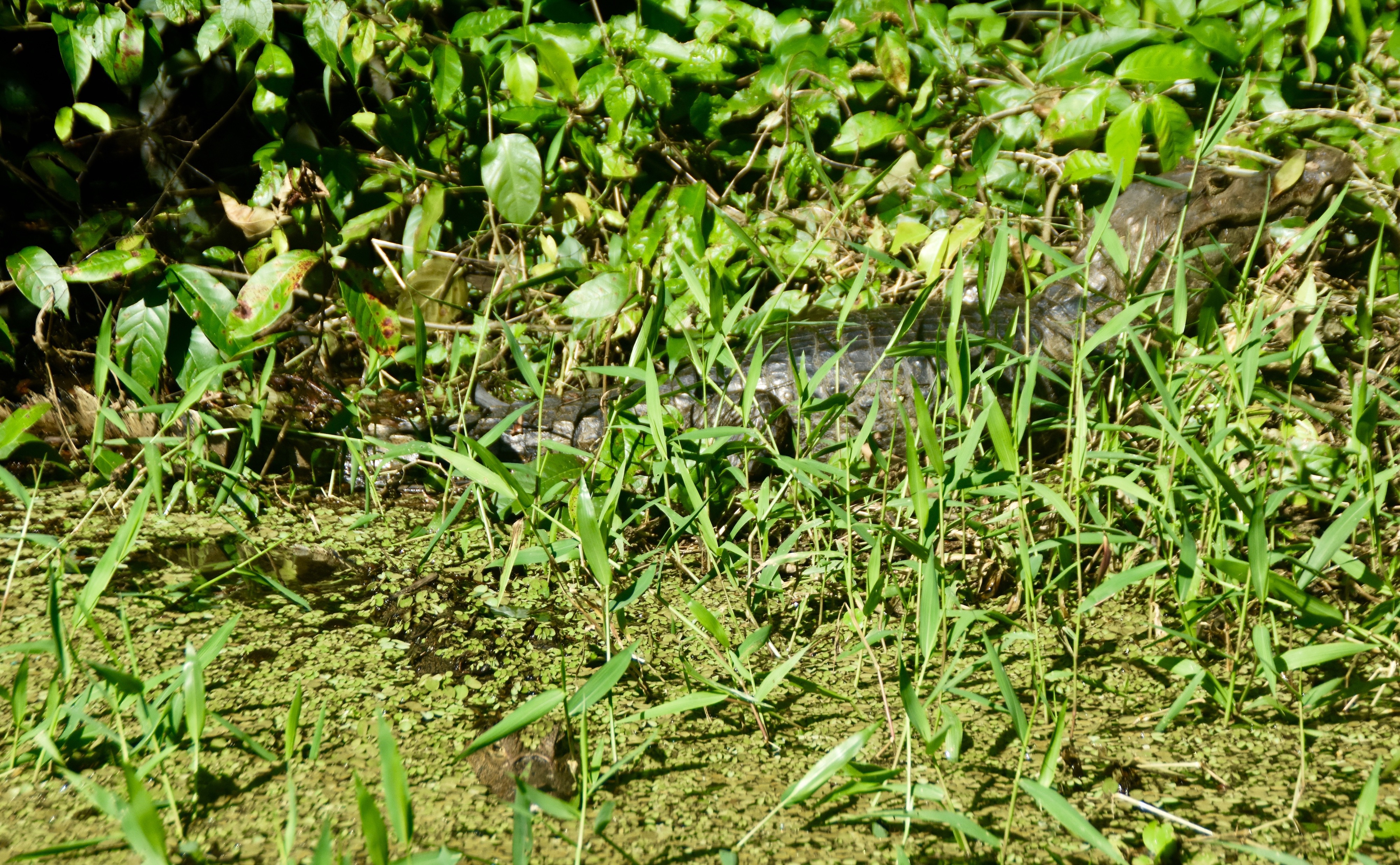
In places the canals narrowed considerably and spider webs brushed across the boat as we penetrated further into the waterway, the first boat of the day to do so.
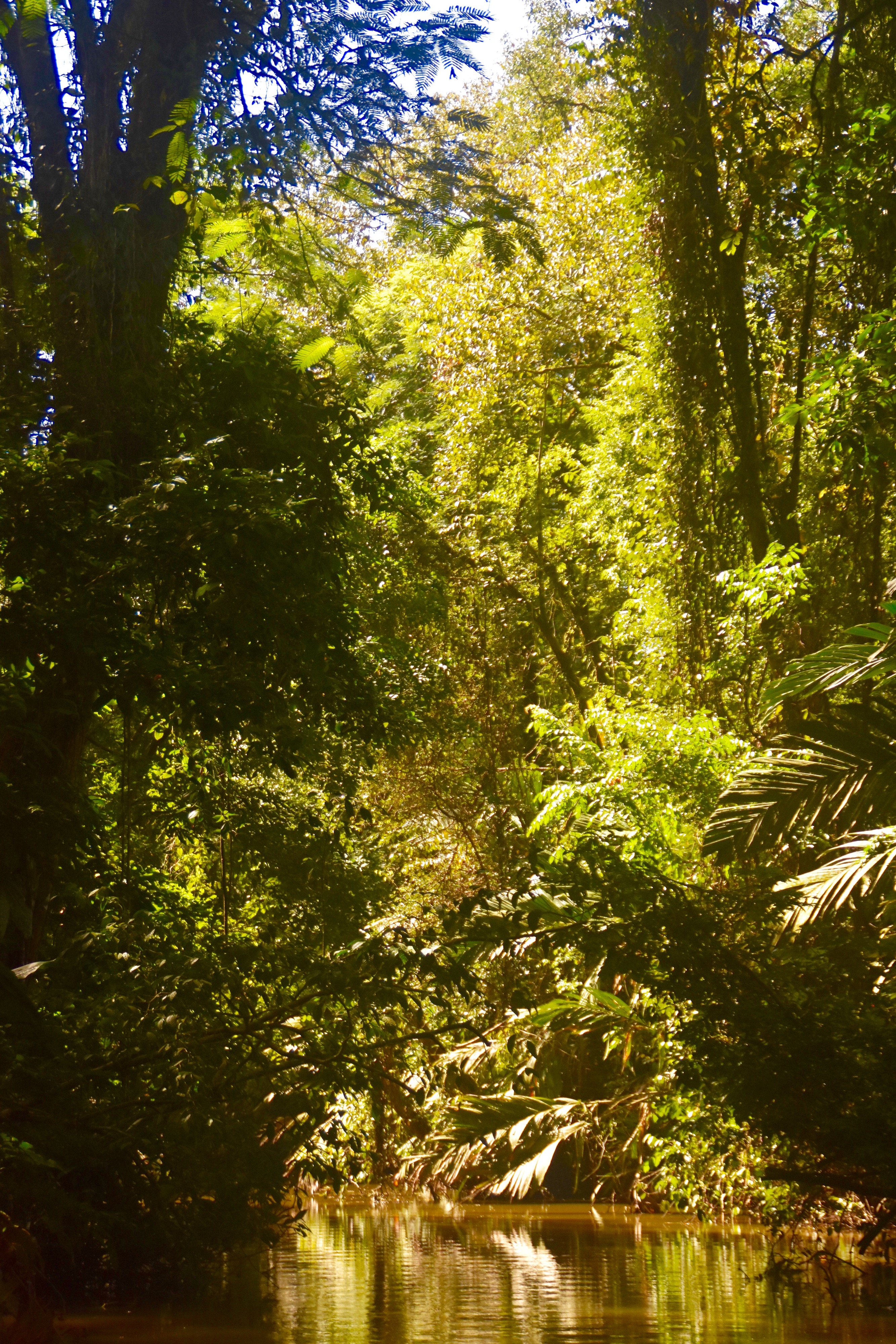
This is a fishing spider and if you are an arachnophobe, then the size of this one would freak you out.

Up in the trees iguanas dozed, their limbs and tail hanging lazily over the branches.
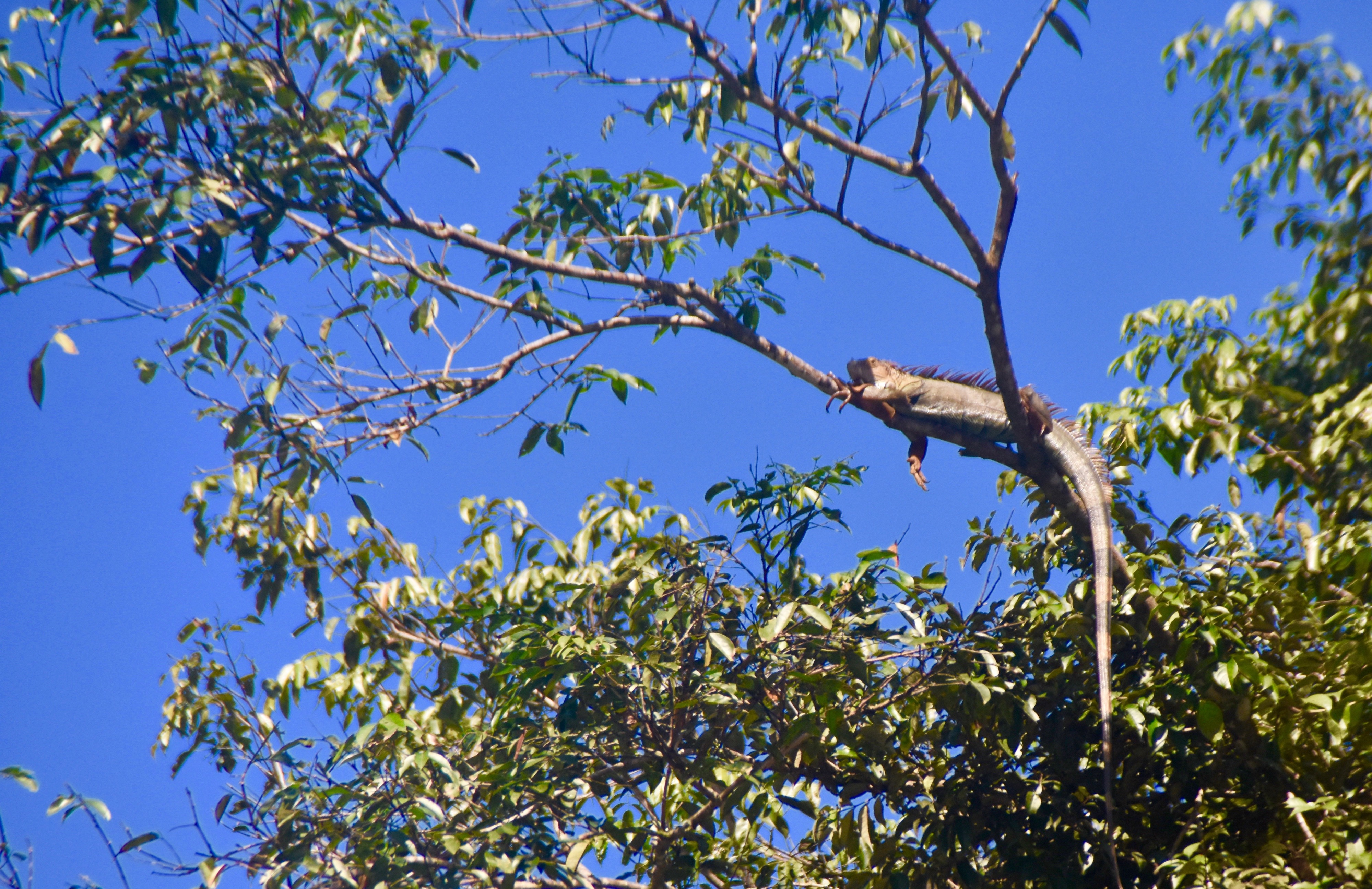
At water level a jacana and her chicks foraged.
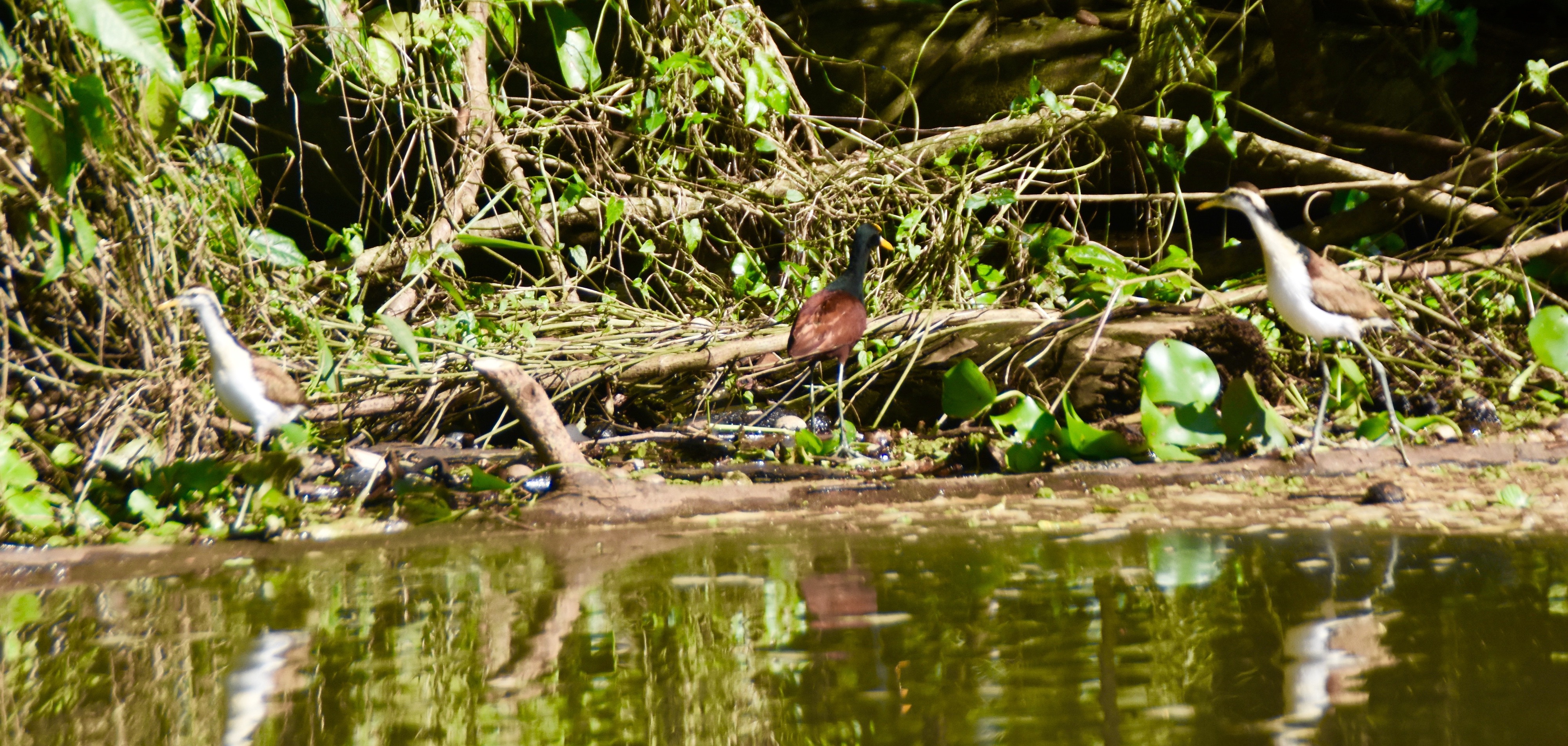
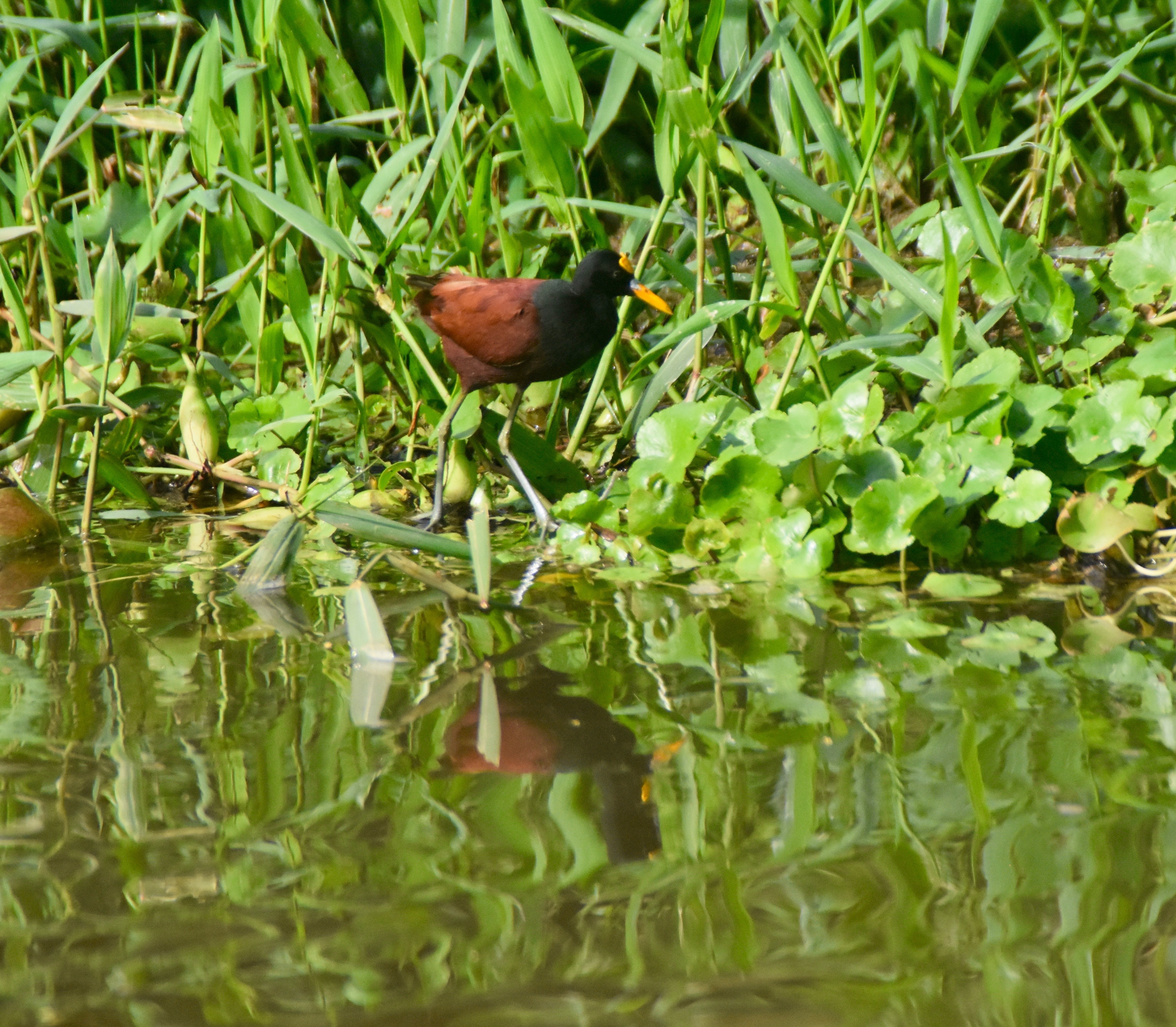
A black river turtle warily kept his eyes on us from his perch on a rotten log.
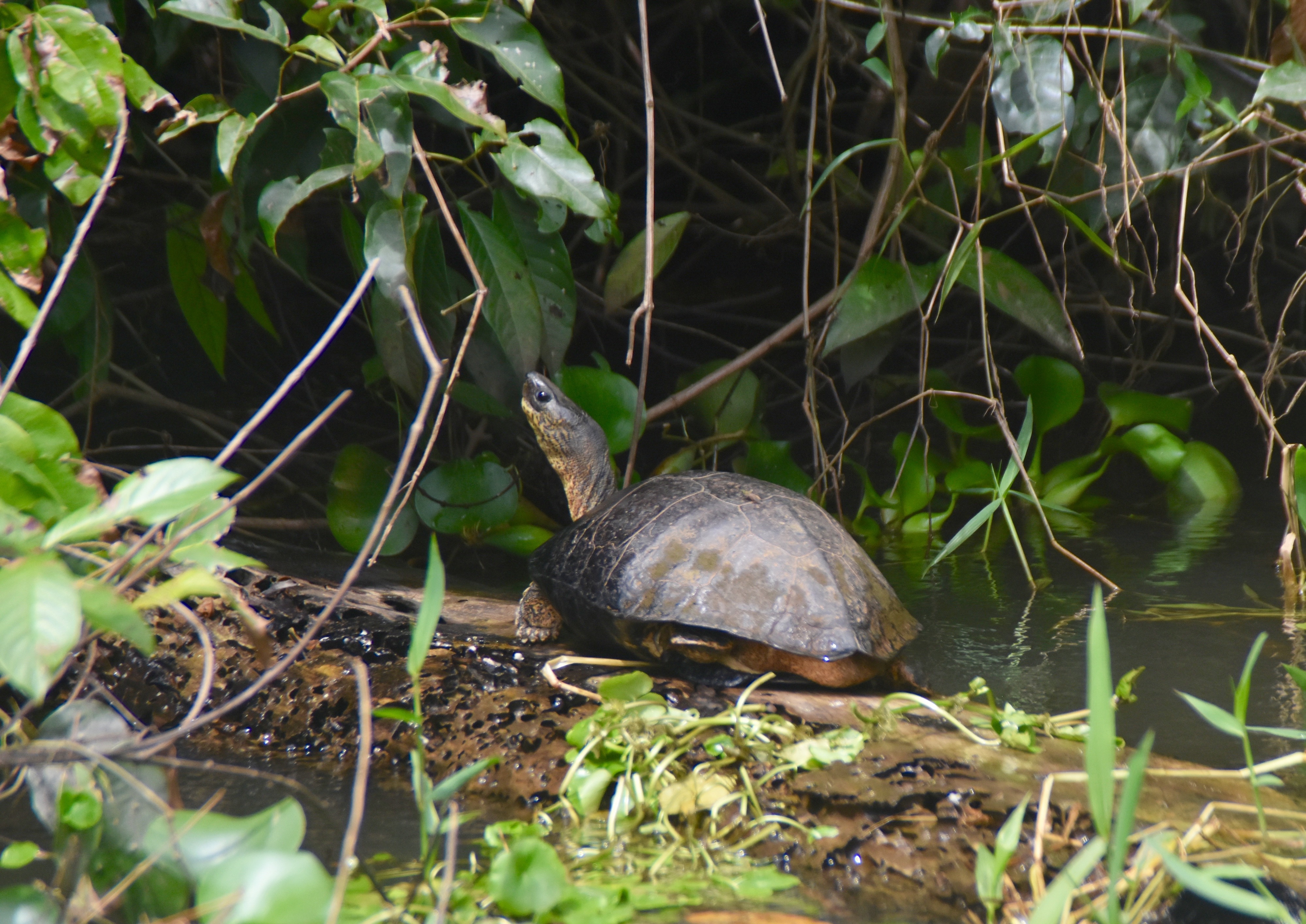
Judging from the bulge in its neck this Little Blue Heron had some success in its earl morning hunt.
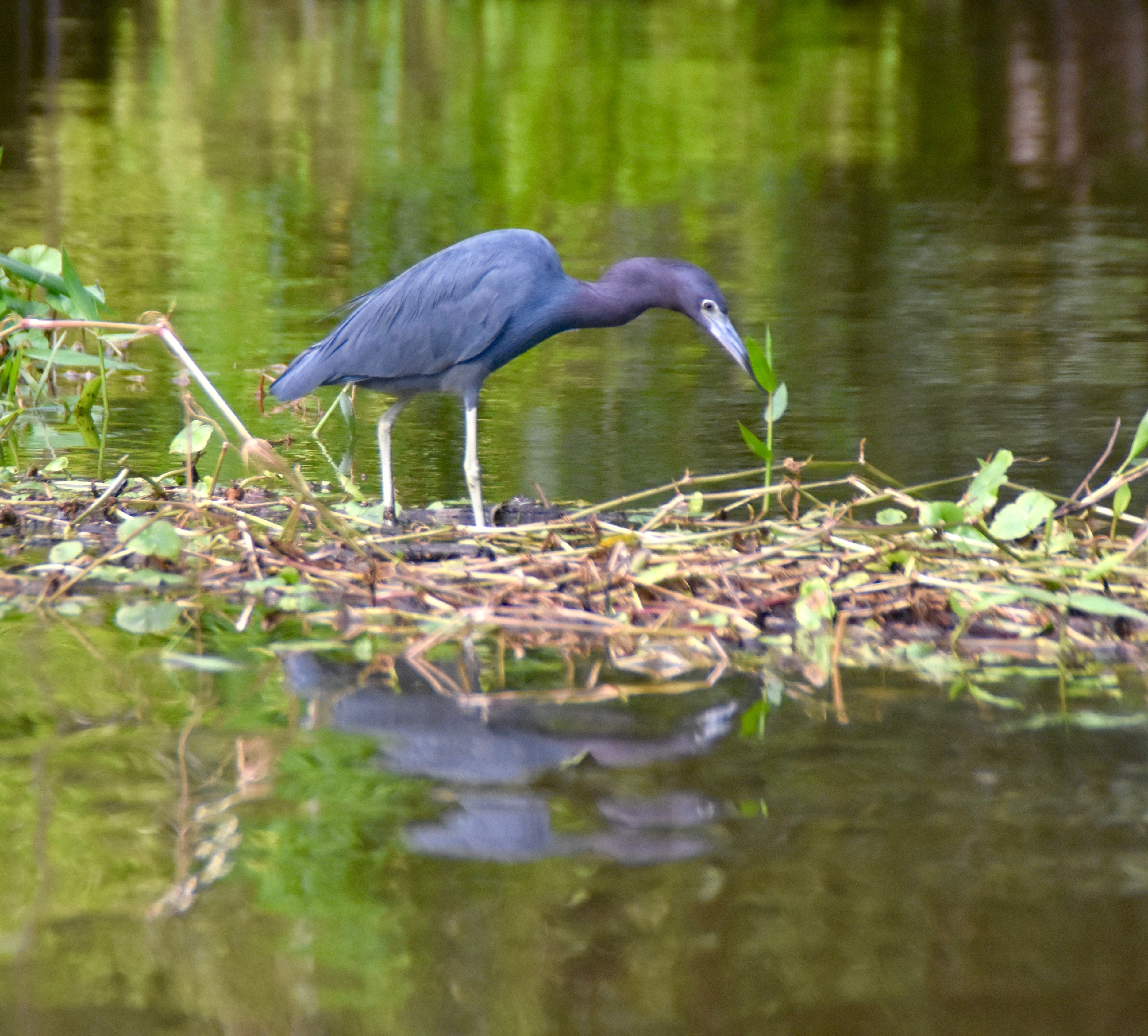
This is a basilisk which is also called the Jesus Christ lizard because it can literally walk, run actually on water. I was really hoping this guy would get spooked and put on a show, but he probably had learned that big goofy looking things in bright orange vests posed no threat.
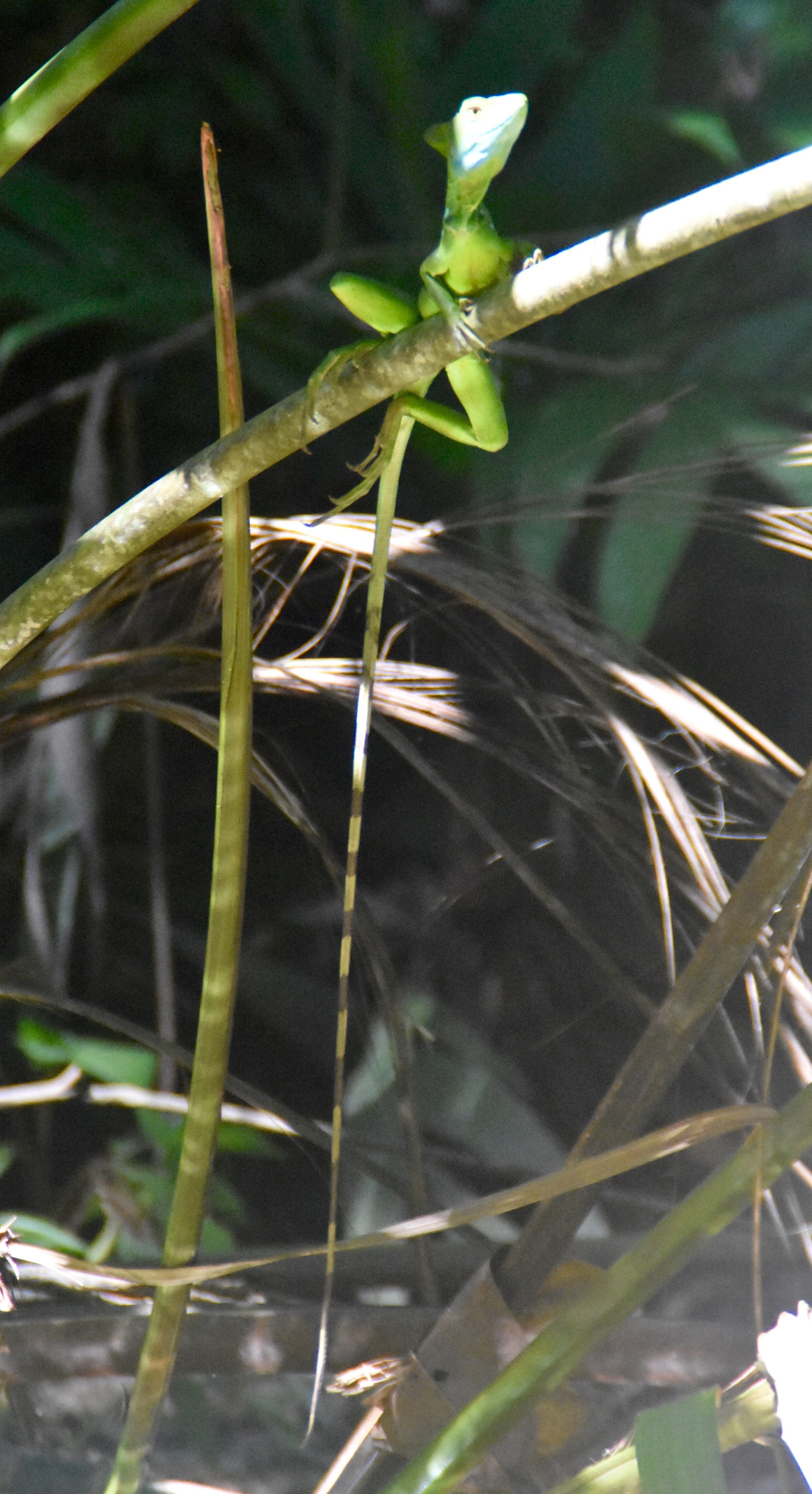
We saw much, much more than just what is in these photos including a black-headed trogon, anhigas, night herons, macaws and other bird species. It was a fantastic morning to go hunting – with a camera.
The Jaguar Trail, Tortuguero
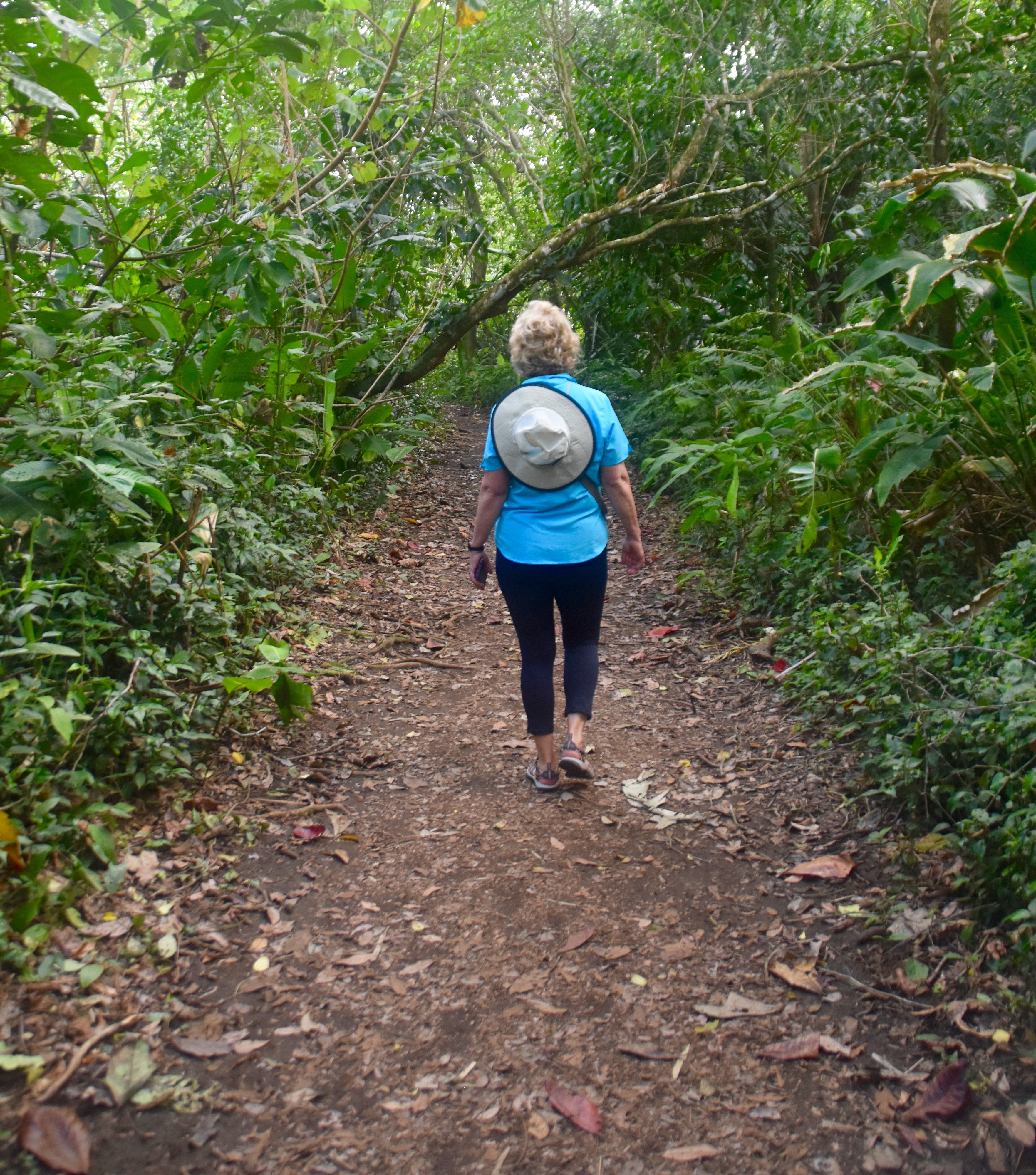
We had one more session with a local guide on this far too brief trip to Tortuguero. This was the Jaguar Trail with starts right in the village and runs parallel to the beach though the forest in a habitat that is frequented by jaguars. In fact, our guide pointed out a fenced yard near the start of the trail where he said a jaguar had killed two dogs only a week or so before. I didn’t expect to see jaguars as they are mostly nocturnal and smart enough to avoid humans if they can, and we didn’t. But we were entertained for quite a while by a troop of spider monkeys in the trees right over our heads. They seemed to be as amused by us as we were of them.
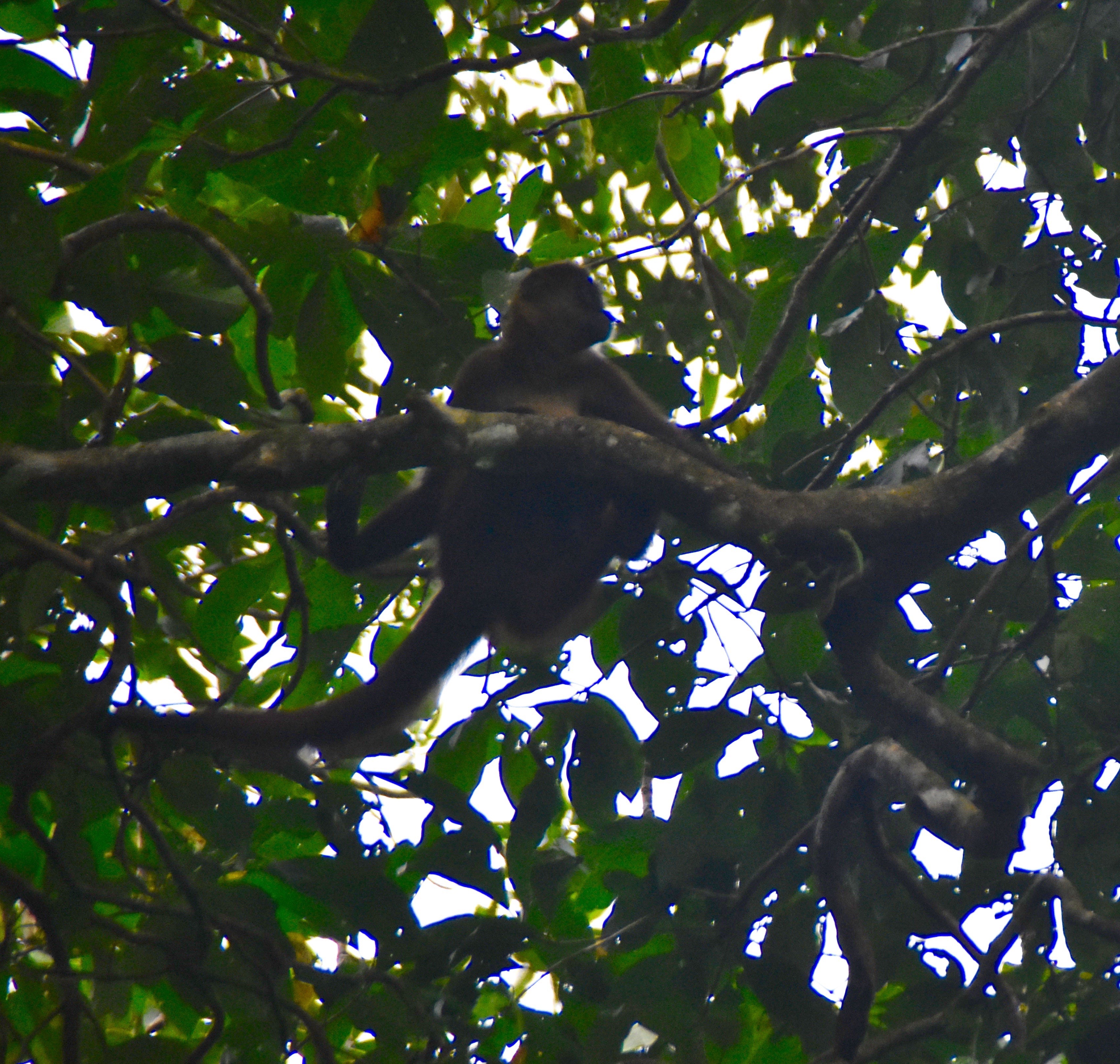
Jaguars are not the only dangerous creatures in this area. This is an eyelash viper, a tiny snake with a big bite. Although it’s not aggressive its bite can be fatal. Our sharp-eyed guide spotted what I had already walked past, not three feet off the trail.
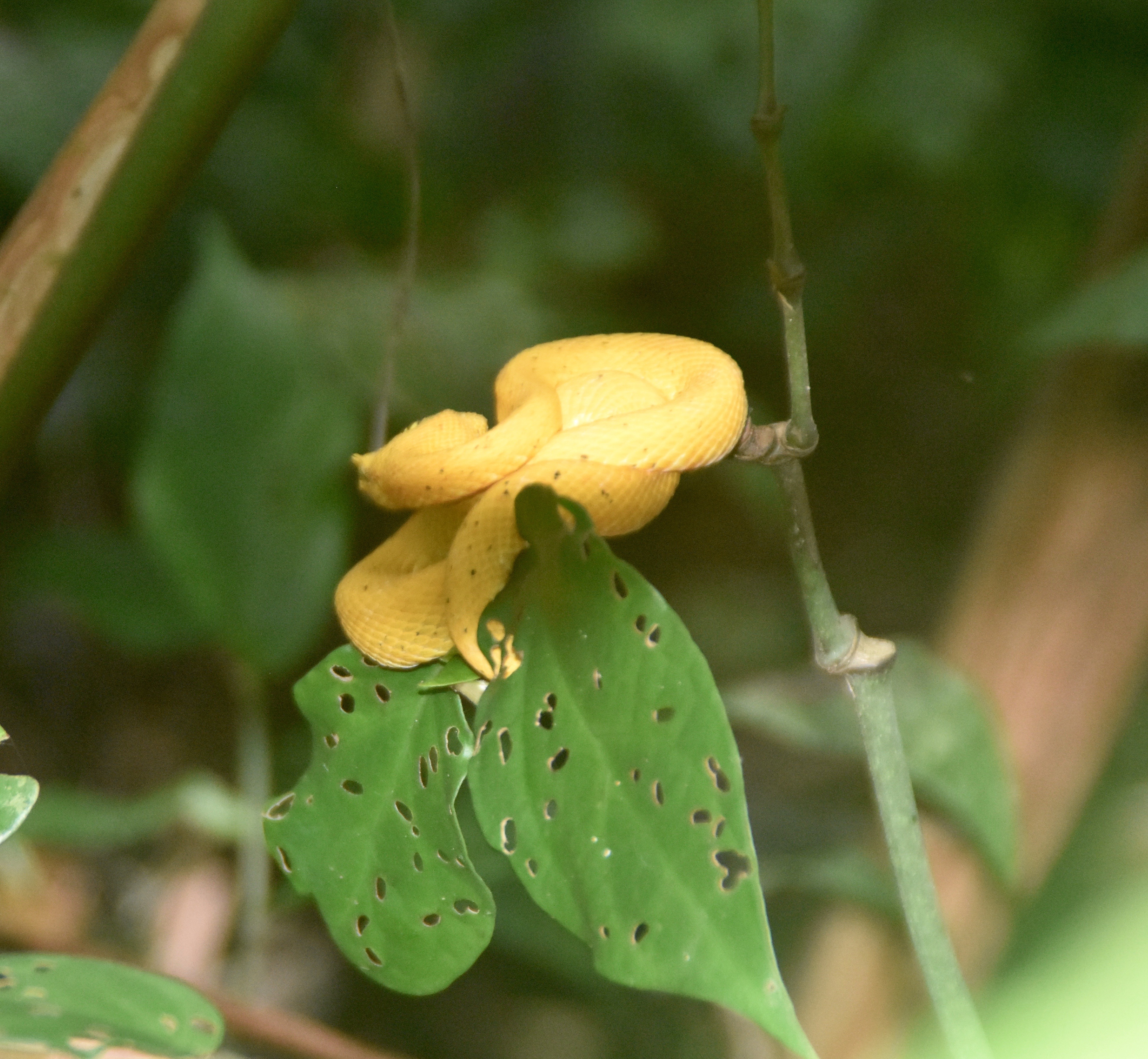
After the walk Alison and I walked back to Junie’s via the beach insecure in the knowledge that in a few days we would be back in the Great White North and might not see another beach like this for many months.
If you are going to Costa Rica and you love nature then you must visit Tortuguero. You won’t regret it.

